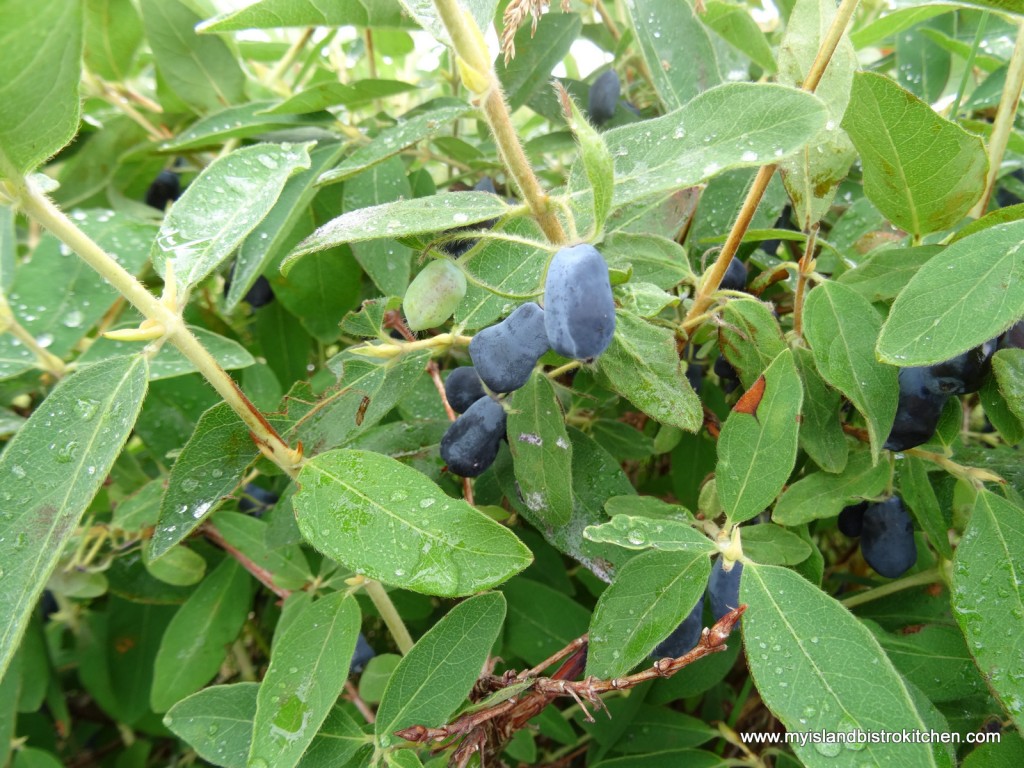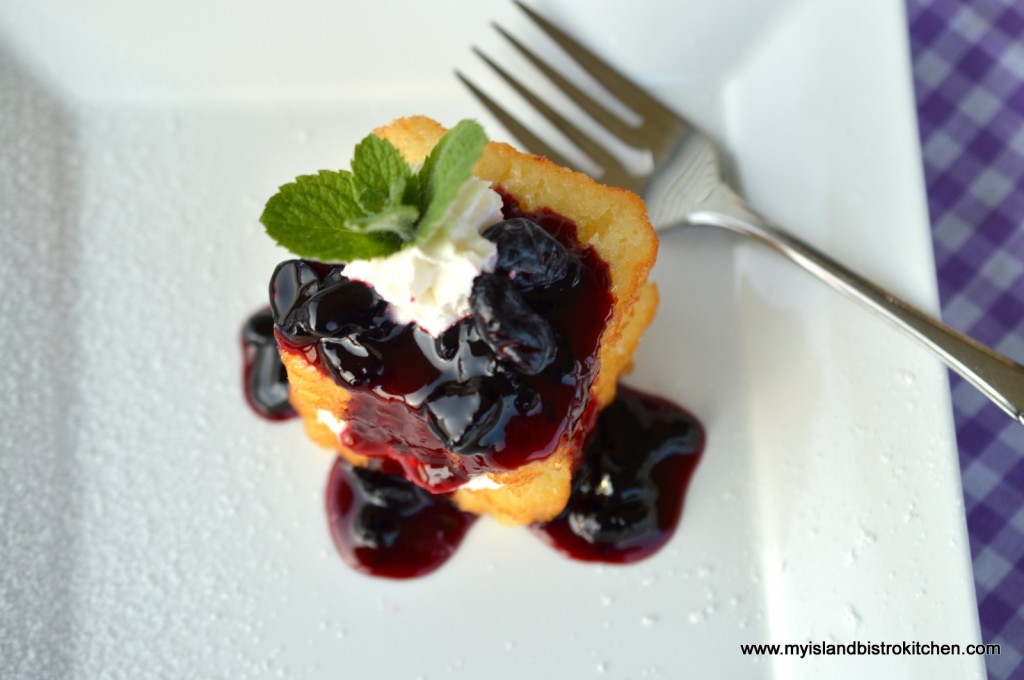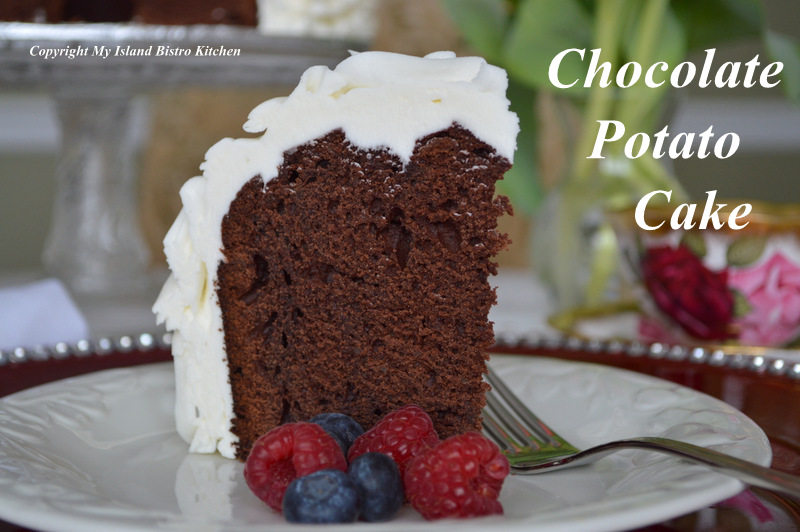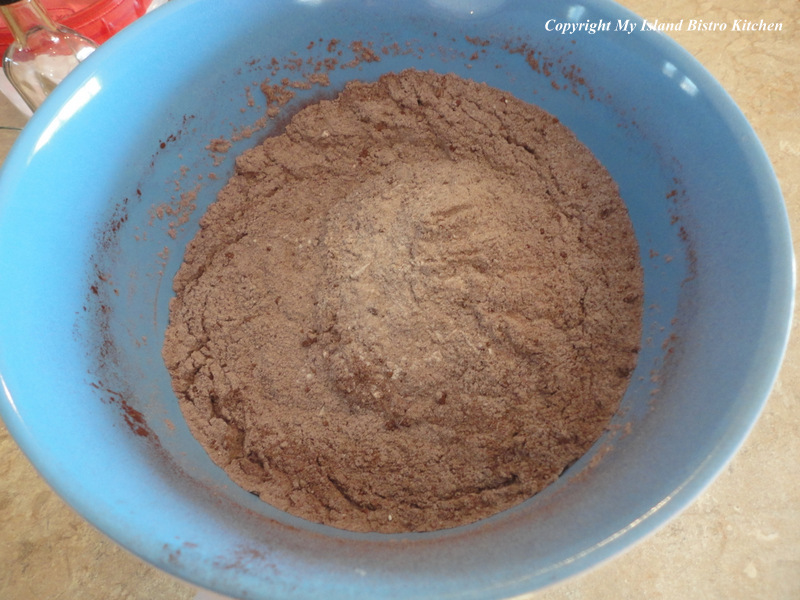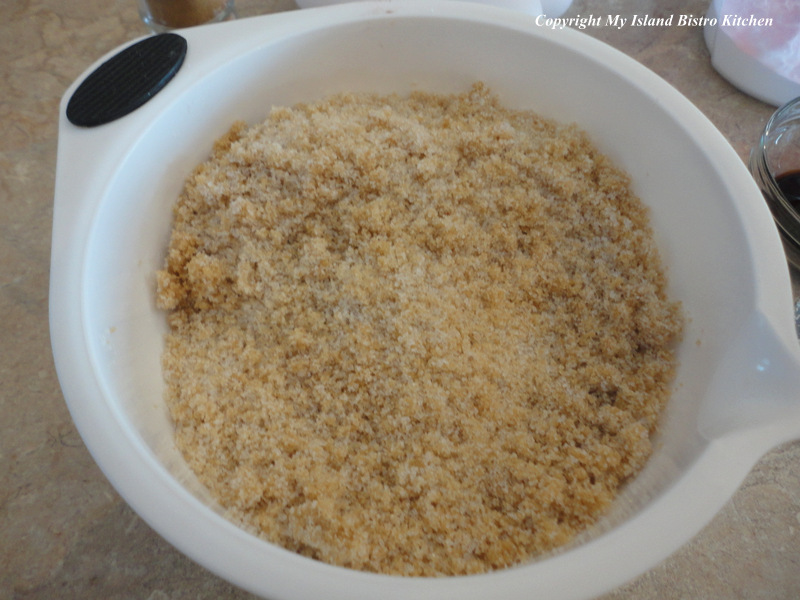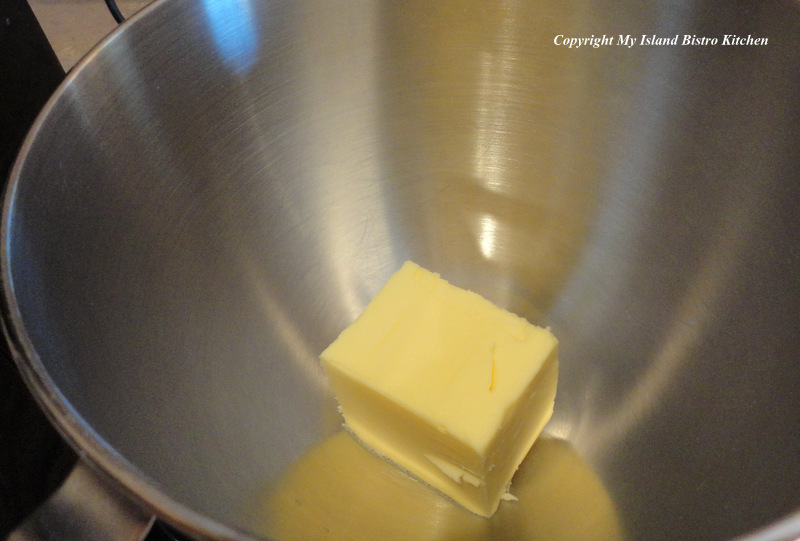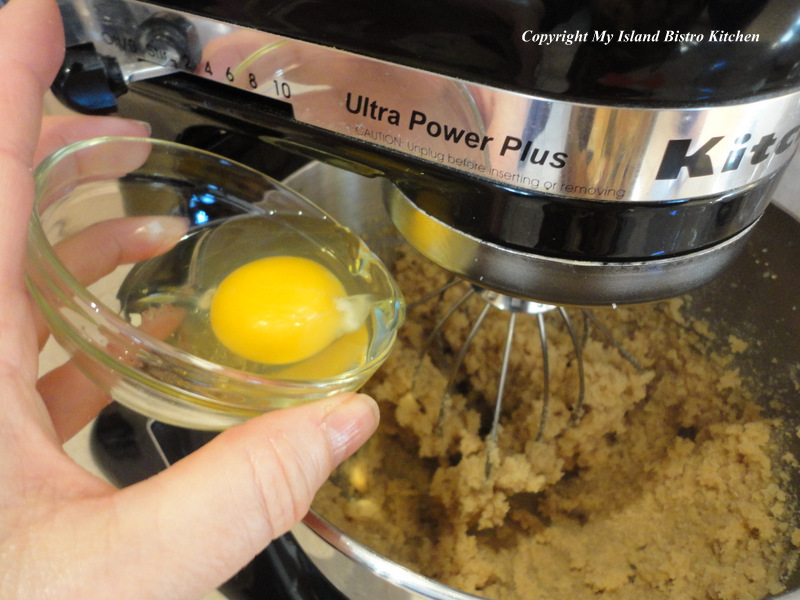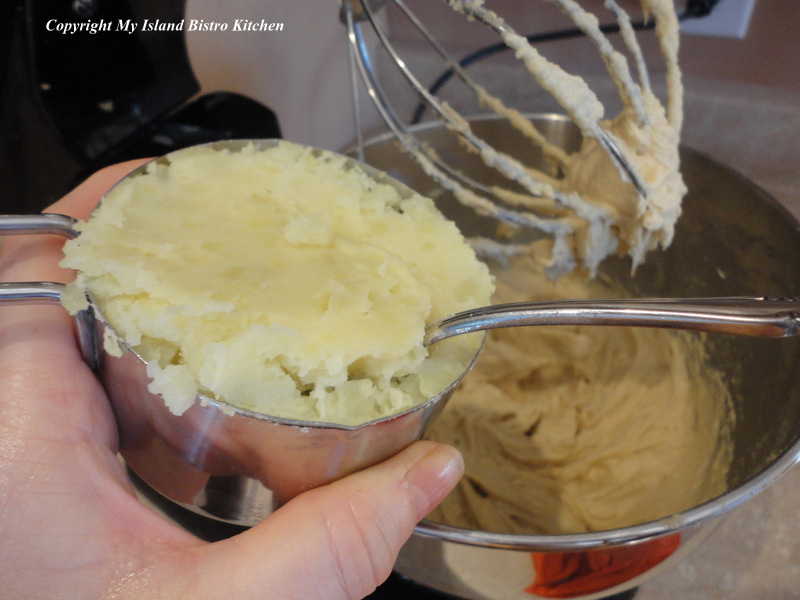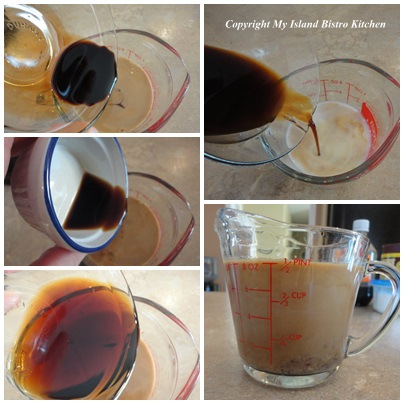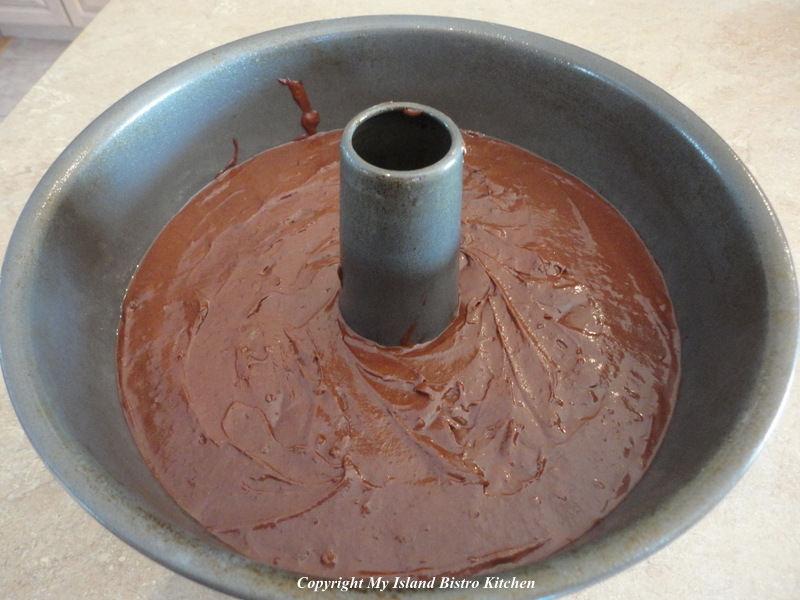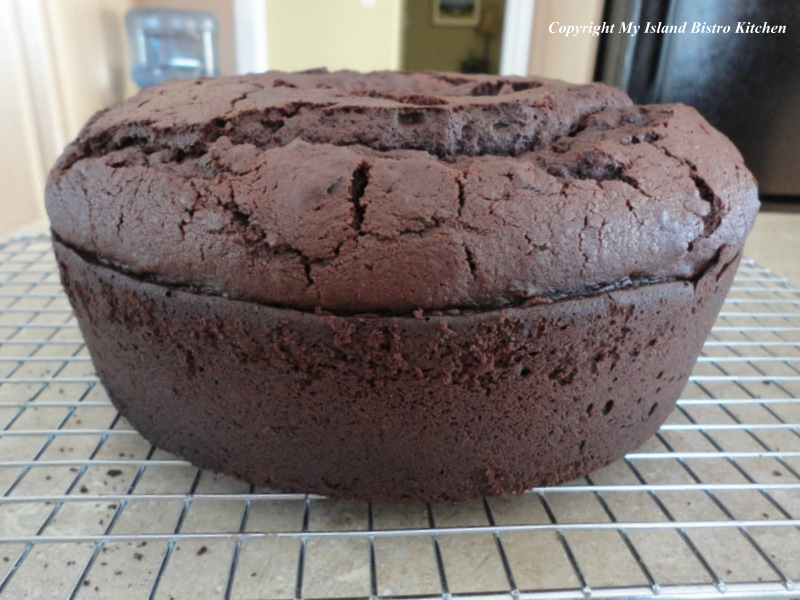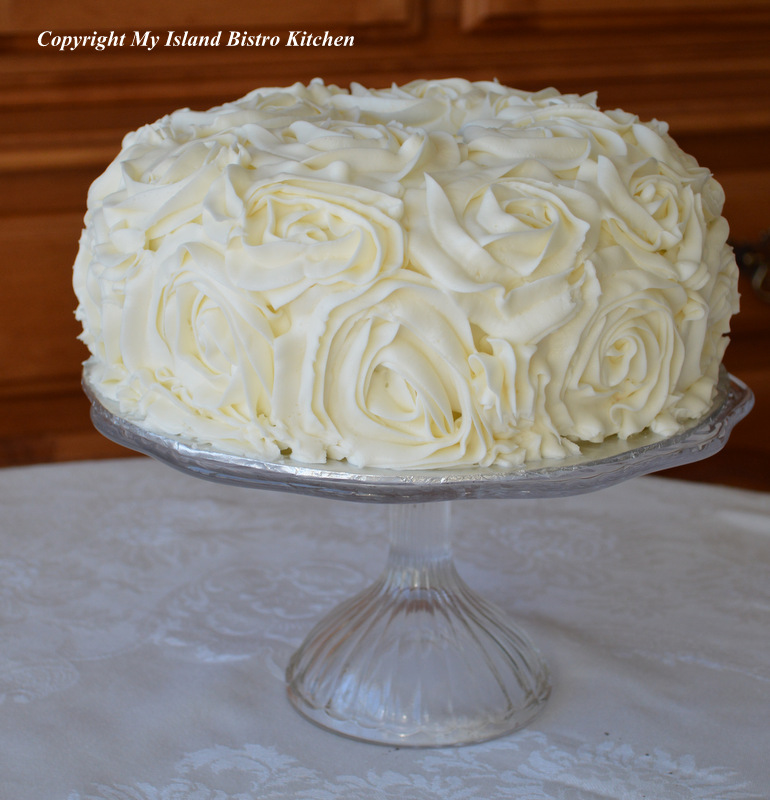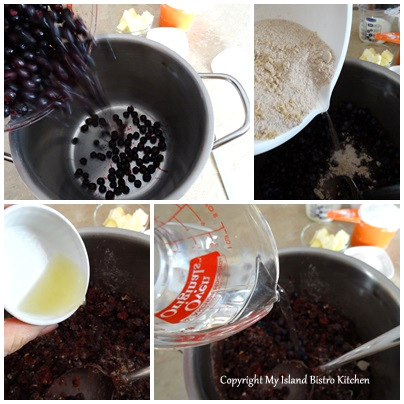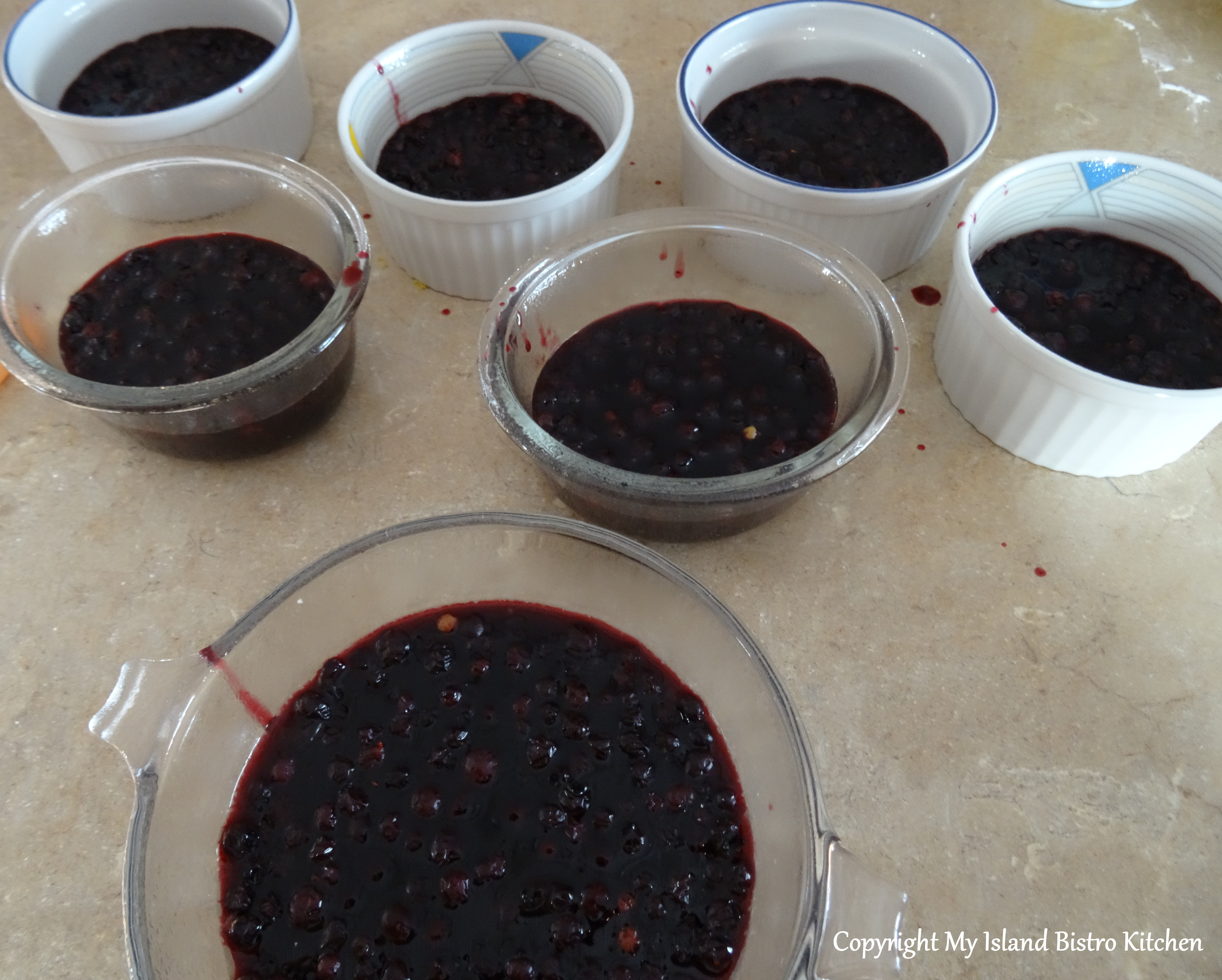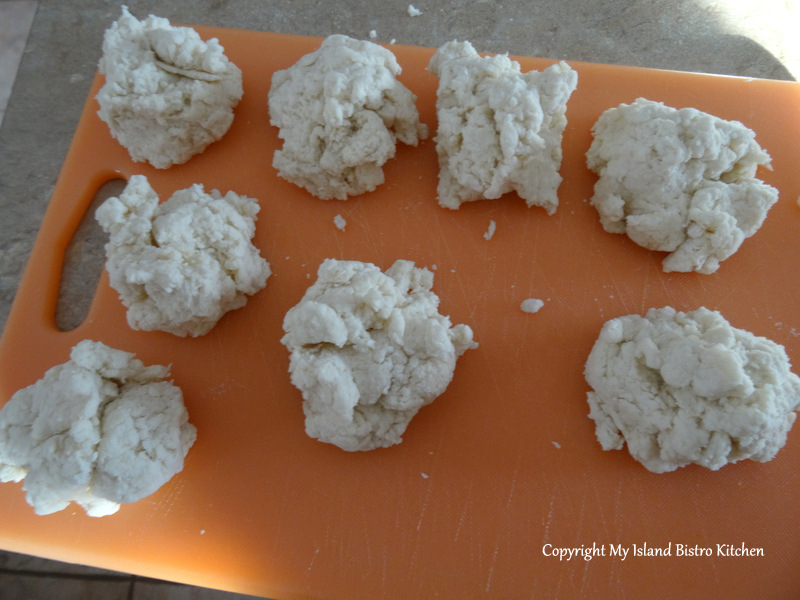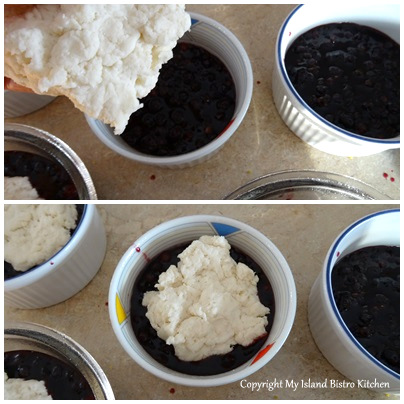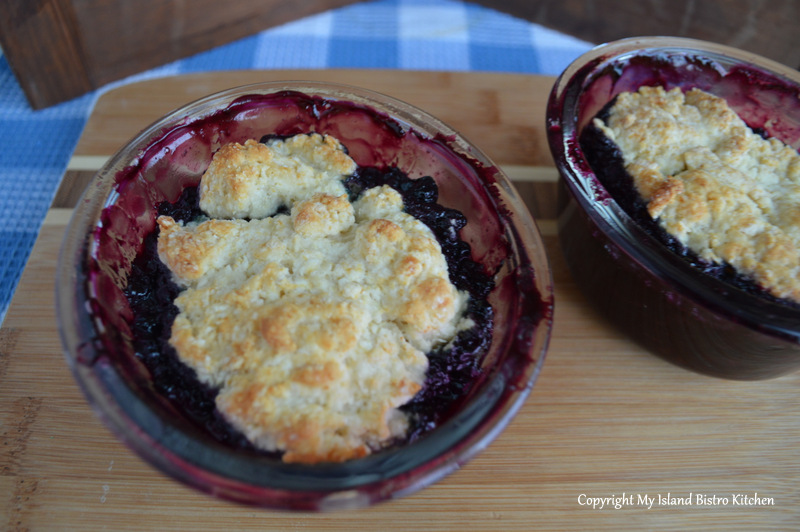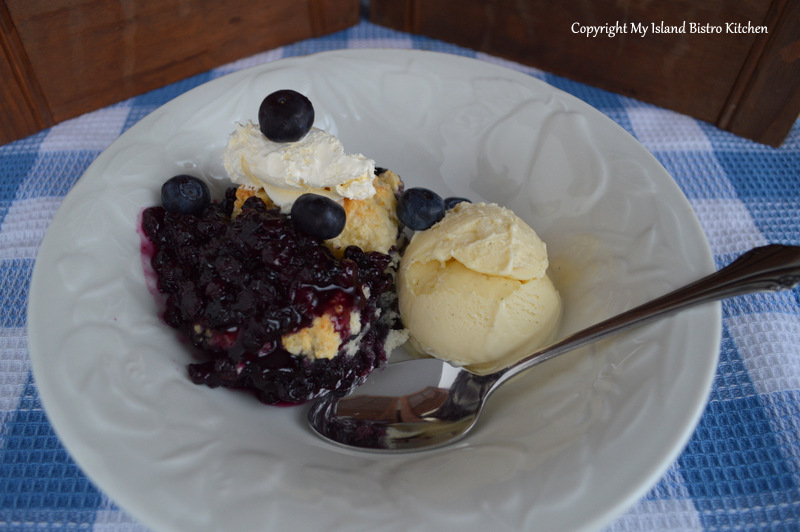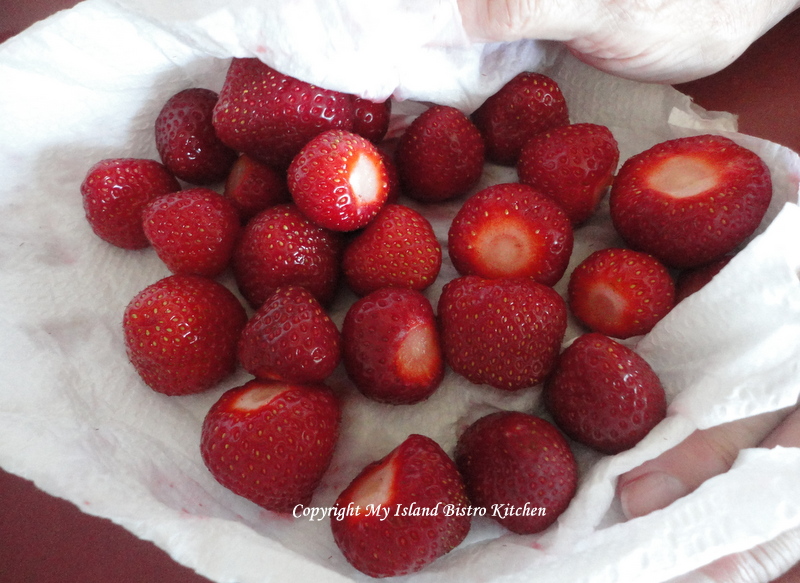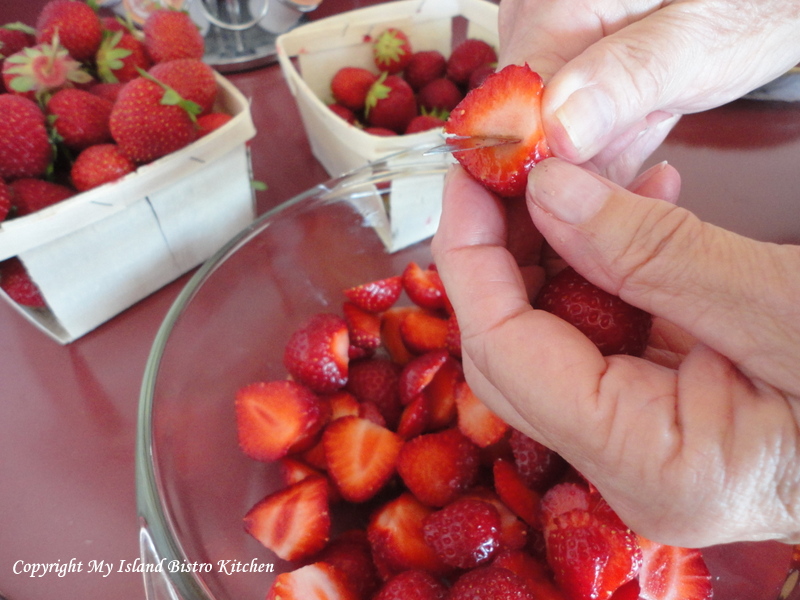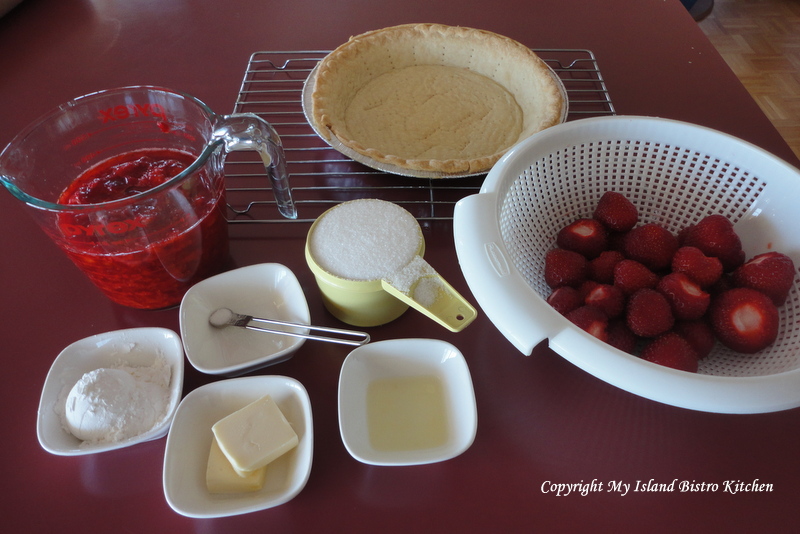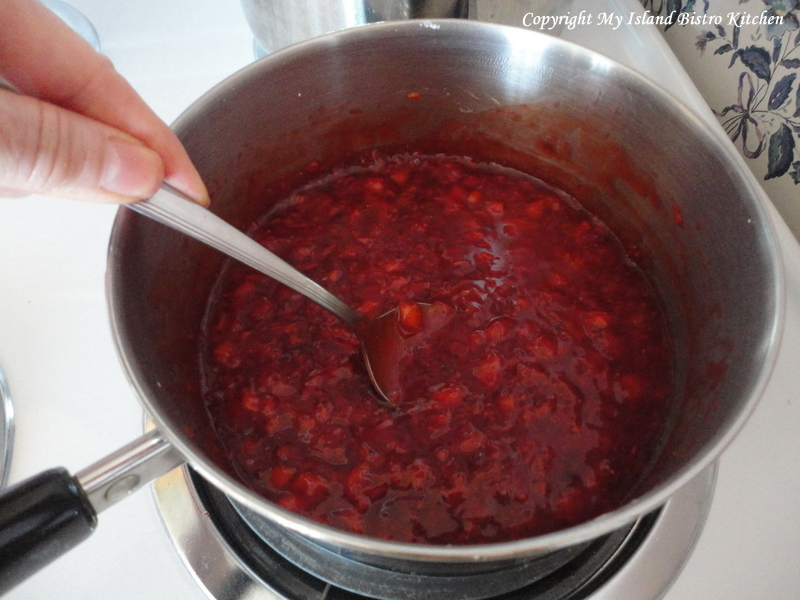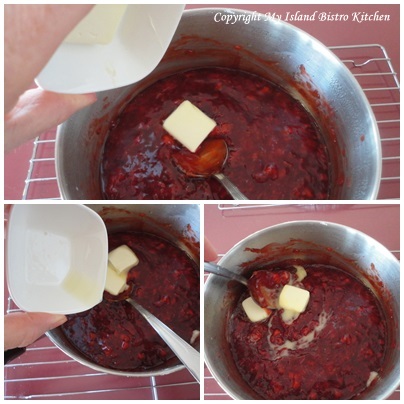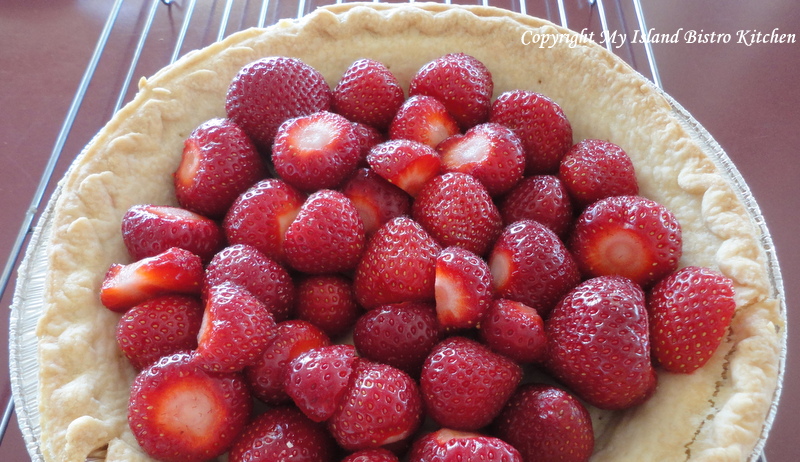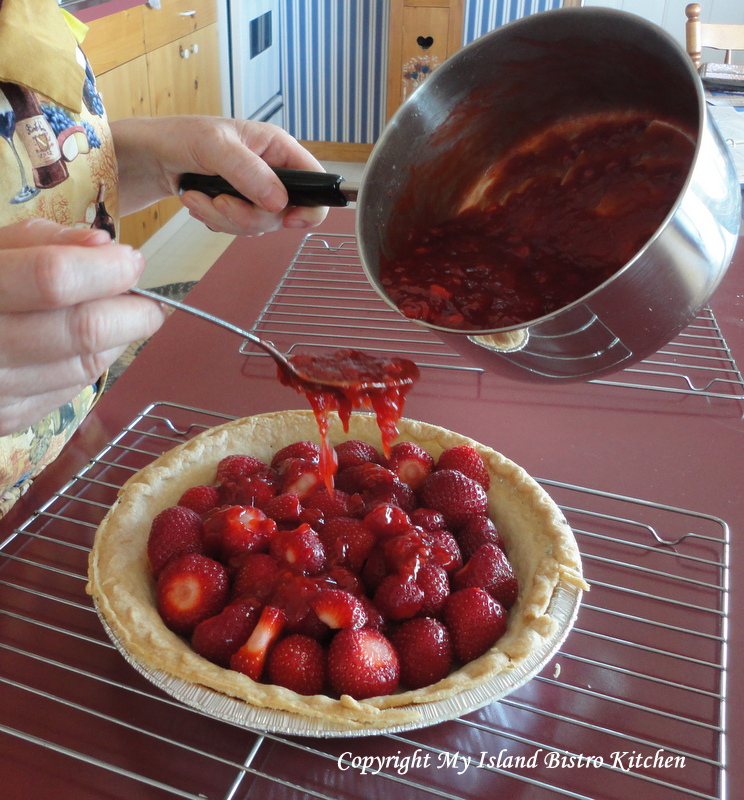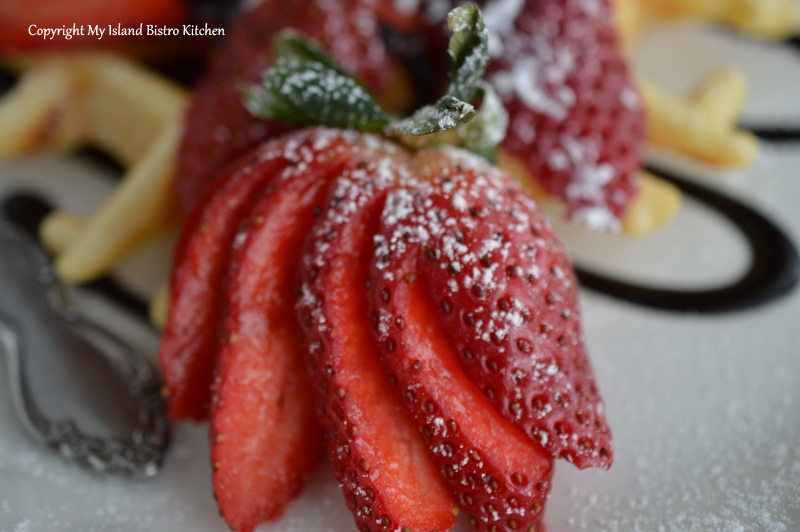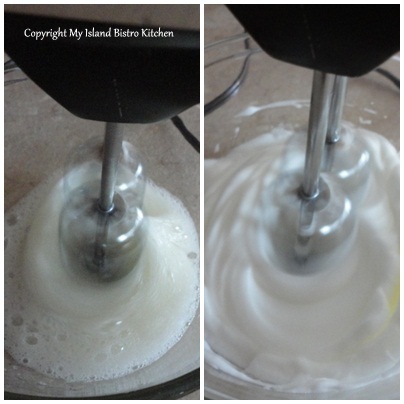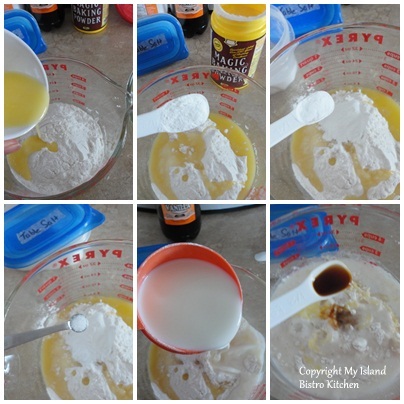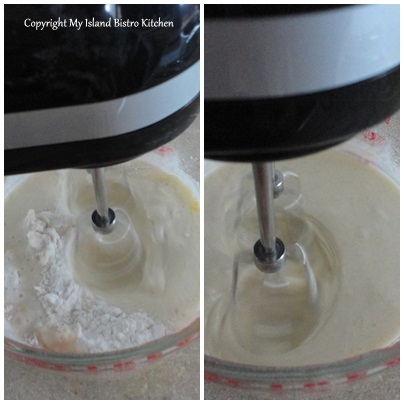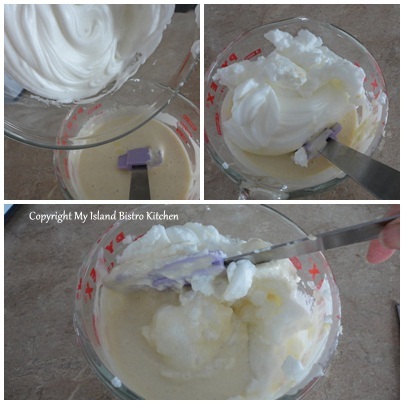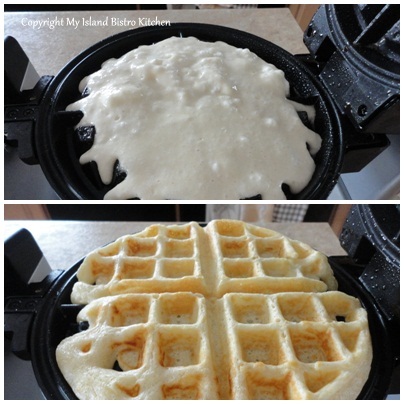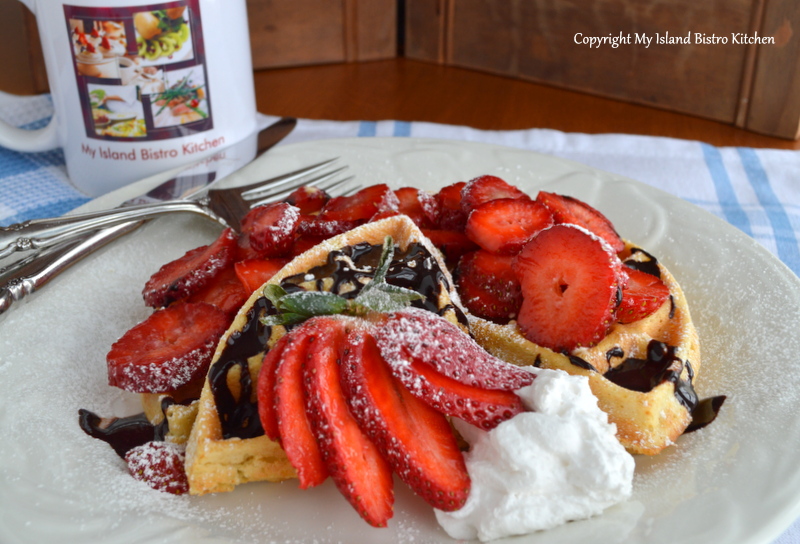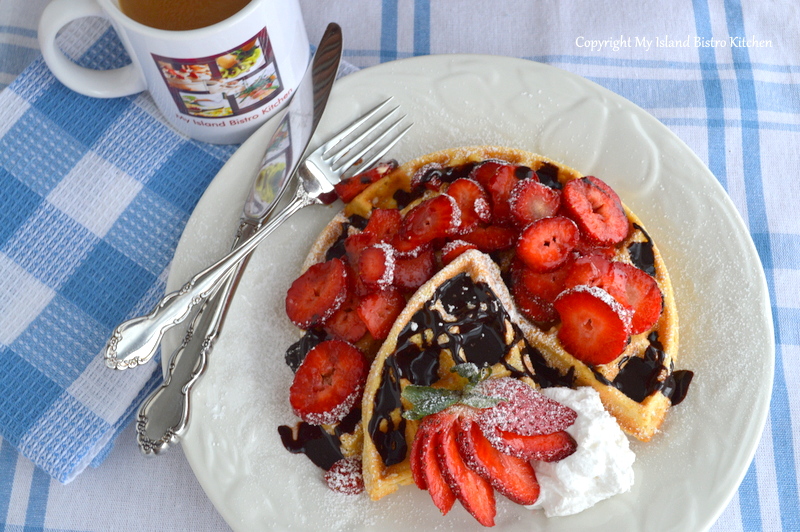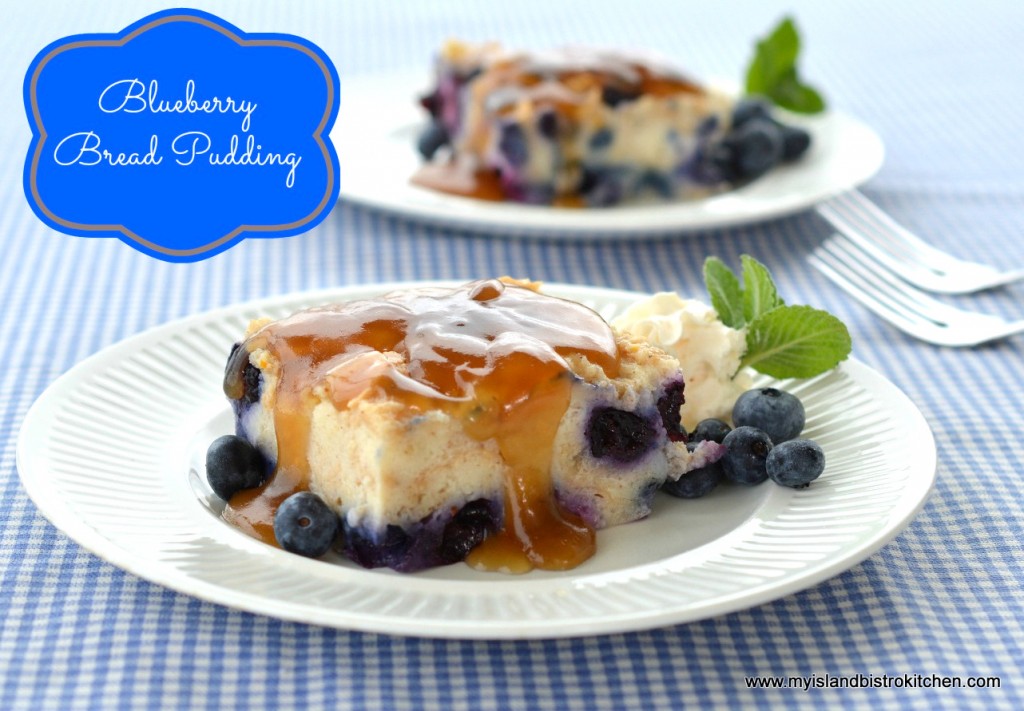 Oh, those gorgeous big highbush Blueberries! They just beg to be made into Blueberry Bread Pudding! Continue reading Blueberry Bread Pudding
Oh, those gorgeous big highbush Blueberries! They just beg to be made into Blueberry Bread Pudding! Continue reading Blueberry Bread Pudding
Category Archives: Desserts
Caps off to Haskaps – A Trendy New Berry on PEI
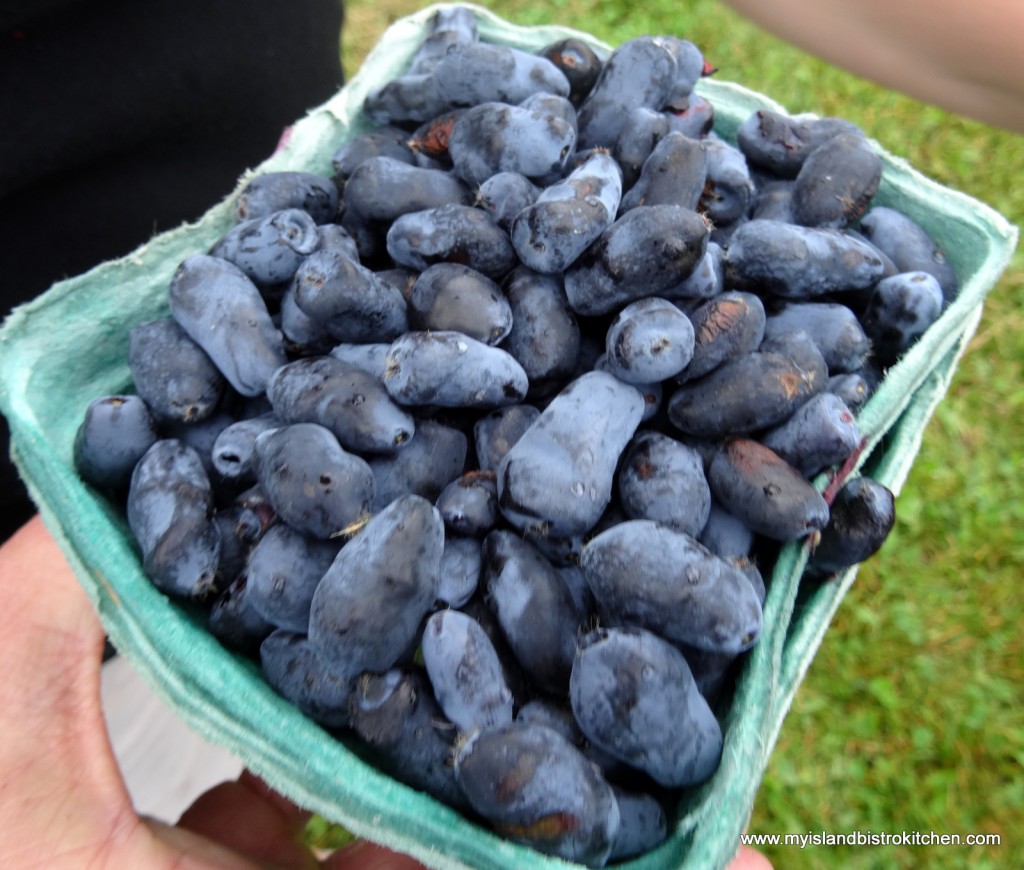
It’s not often that I discover a new food on Prince Edward Island. Until recently, I had never heard of haskap berries and did not know that they were grown on PEI. Earlier this month, I travelled to Rollo Bay in the Eastern end of the Island to view a five-acre field of haskap bushes and to have a chat with the growers.
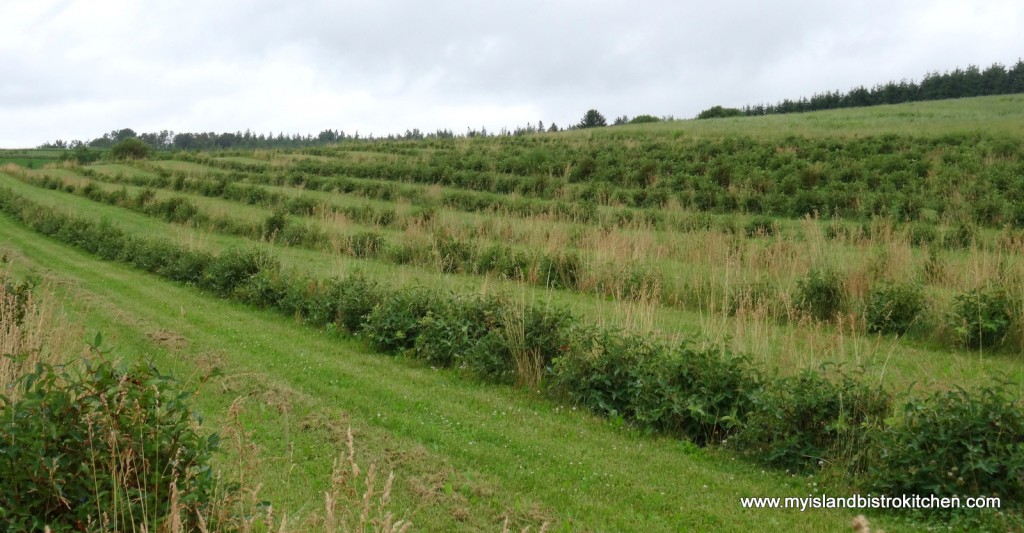
Mother and daughter duo, Lynn and Becky Townshend, began growing 2500 haskap bushes five years ago. Haskap bushes are very hardy and can withstand cold winter temperatures. They are also fast-growing and, once established, are one of the season’s earliest plants to bear fruit.
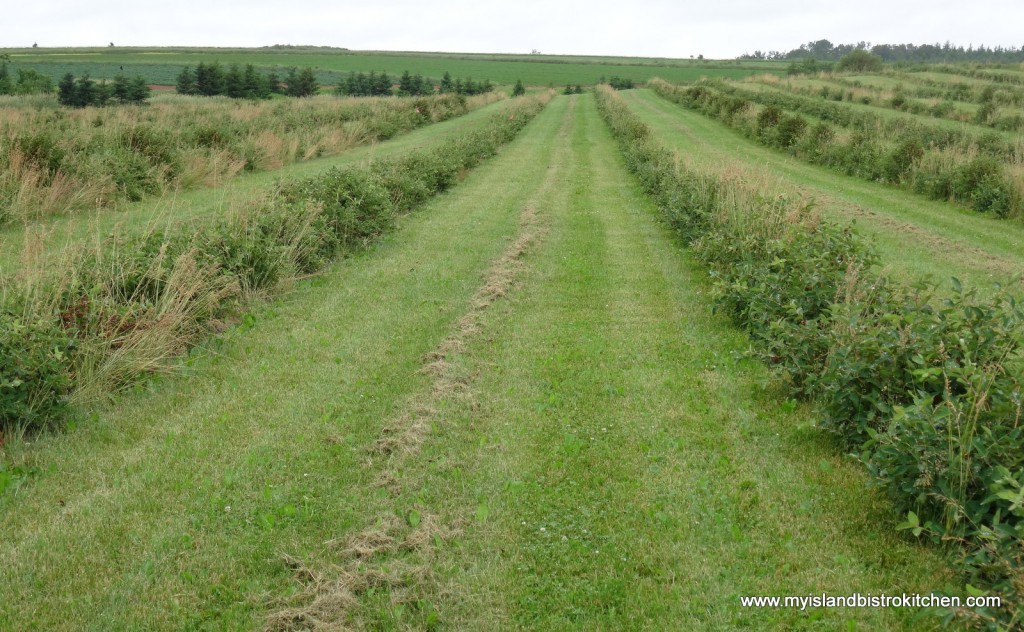
Before meeting the Townshends, I did a little research on the elongated-shaped berries which are the color of blueberries. I imagined they would grow on a low bush and, because they somewhat resemble blueberries, thought they would taste something like traditional blueberries. However, that is not the case. Their color is where I find the similarity with blueberries ends. They grow on high bushes like the ones in the photograph below. These are five-year old bushes and they range in height probably between about 3-5 feet.
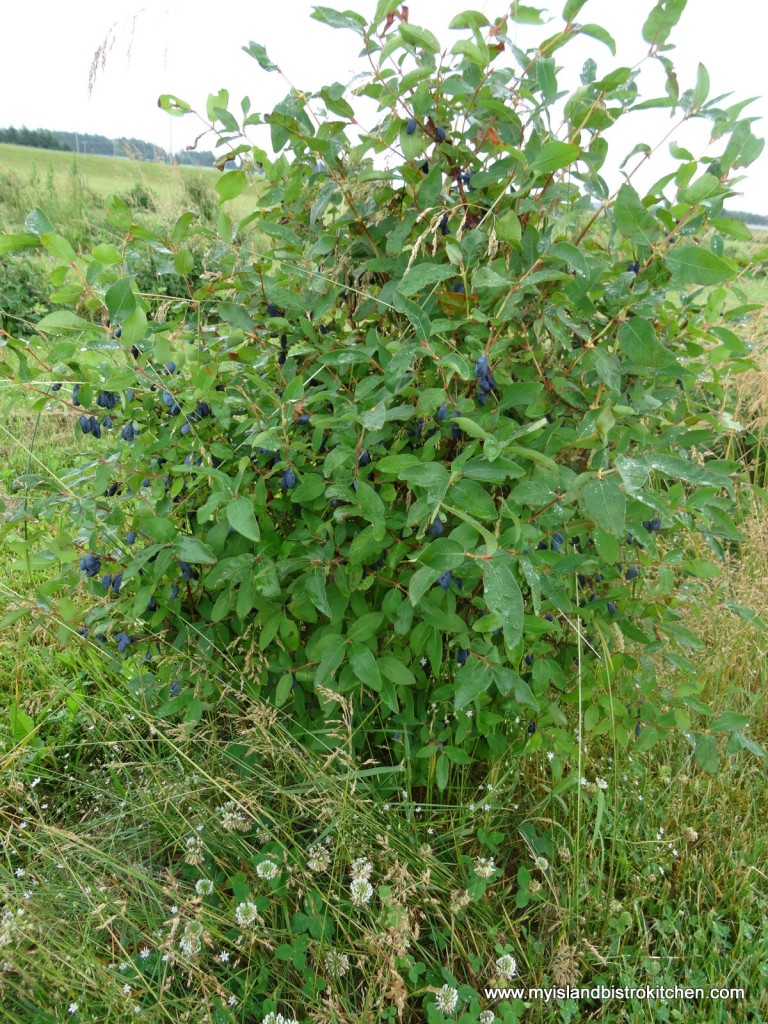
Haskaps have their origin in Siberia and are also found in Russia, Japan, and China. A few years ago, Dr. Bob Bors at the University of Saskatchewan developed the haskaps for commercial production. Haskaps are a member of the honeysuckle family and are sometimes referred to as honeyberries.
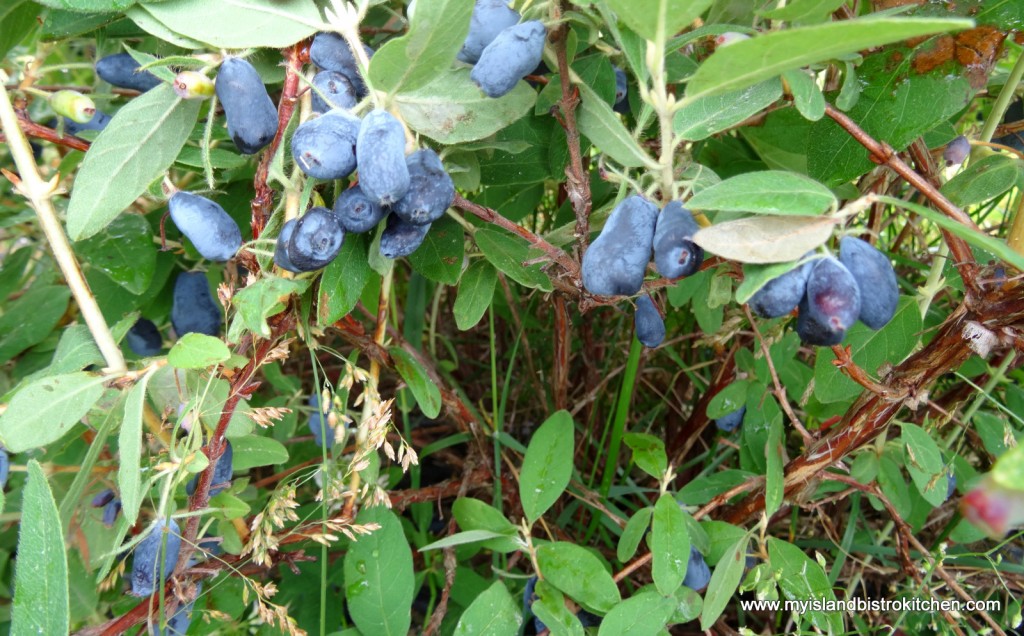
The Townshends grow four varieties of haskaps -Indigo Gem, Indigo Treat, Tundra, and Borealis. Some varieties are sweeter than others but, for the most part, I would class these berries as tart and they would not be ones I would be likely to eat in a bowl with milk and sugar as I would, say, blueberries or strawberries. Raw, according to my tastebuds, I would suggest the haskaps most closely resemble Concord grapes in flavour while cooked or baked, they are (in my opinion) perhaps closest to black currants.
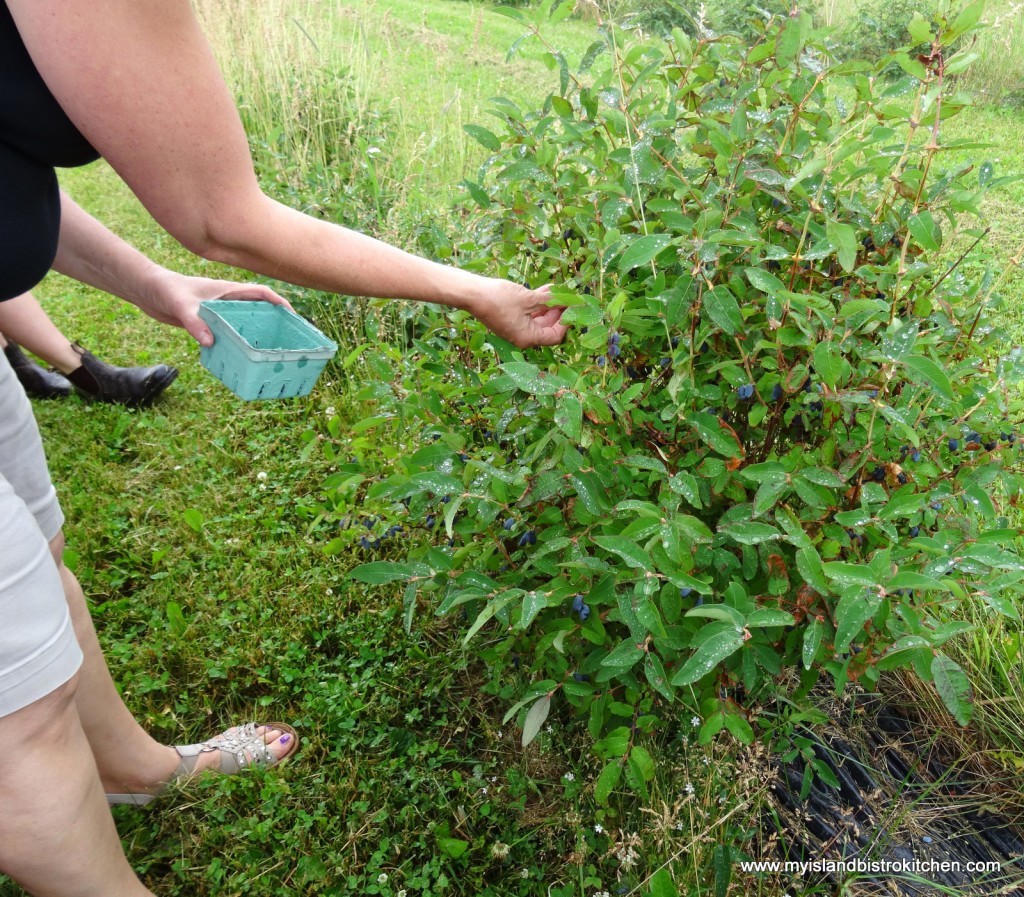
Picking the berries is a tedious and time-consuming task. At present, there is no mechanical harvester available (at least locally) for haskaps which means they must all be picked by hand.
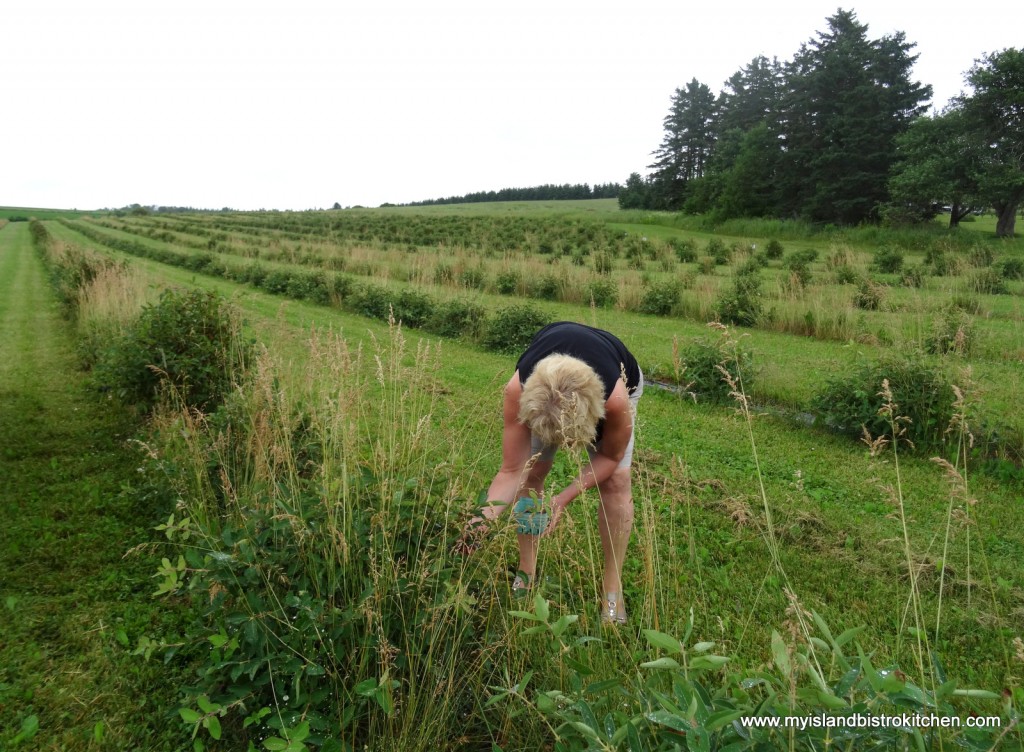
As Becky says, “they’re devils to pick”! This is because the berries grow in through the branches and leaves on the bushes and the branches have to be moved away from the plant to reveal the berries.
This labour-intensive task is what keeps the price of the berries high. At time of writing, Riverview Country Market in Charlottetown sells pint boxes of haskaps for $6.00 each.
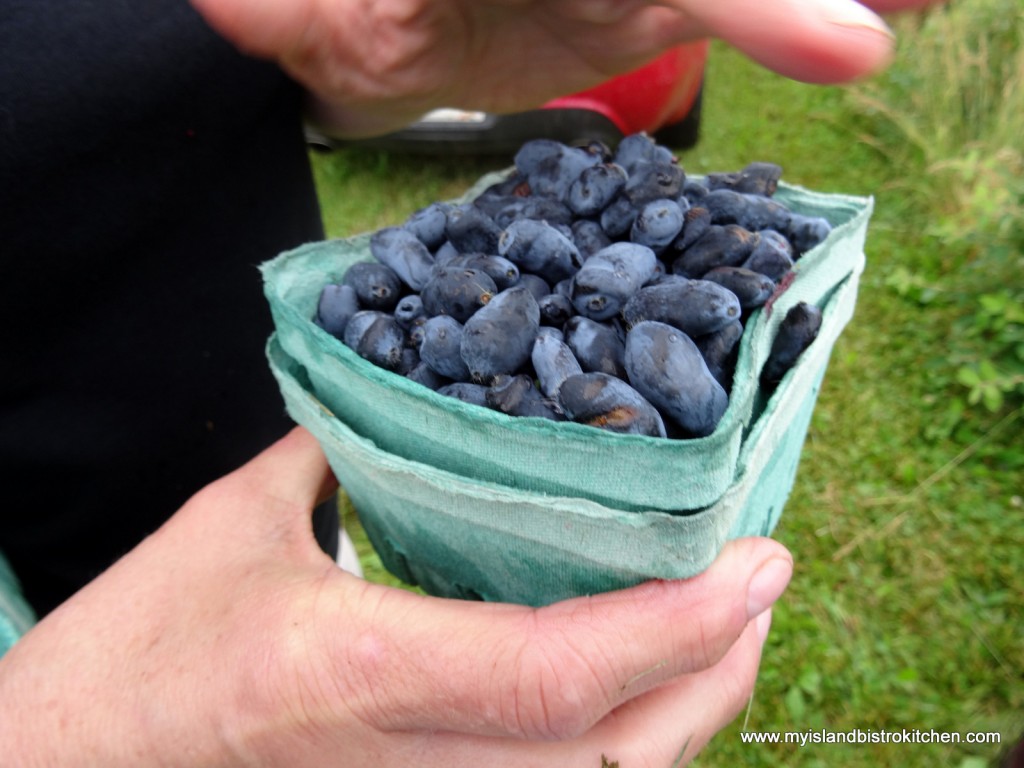
So, what can you do with haskaps? They make a great syrup or sauce for pancakes, waffles, French toast, or over ice cream or as the sauce for a shortcake. They can be used in baked goods, alone or in combination with other fruits such as raspberries or blackberries (I find they pair really well with raspberry – the flavors blend together well). They are suitable for pies, muffins, and baked puddings as well as for jam. Haskap berries also freeze well for later use. Essentially, you could use haskaps in the same manner in which you would use blueberries, raspberries, or blackberries.
The recipe I have chosen to share today using haskaps is for a rich sauce. Adding a mere teaspoon of a high quality raspberry balsamic vinegar and just a dash of cardamom gives additional complexity and flavour to this sauce. This sauce is particularly good in Haskap Shortcake.
Haskap Sauce
Ingredients:
1 cup haskap berries, fresh or frozen
½ cup super-fine sugar (aka caster sugar)
dash cardamom
1 tsp raspberry balsamic vinegar
1-2 tsp water
1-2 tsp cornstarch
Method:
Place haskaps, sugar, cardamom, and raspberry balsamic vinegar in small bowl. Stir gently to release juice from berries. Do not break up berries. Let sit for 3-4 hours at room temperature (can be placed in covered bowl in refrigerator for up to 24 hours) to allow sugar to begin to naturally dissolve and for the flavors of the berries, balsamic vinegar, and cardamom to blend.
Transfer berries to saucepan and add about 1 tsp water or so, just enough so that the berries and sugar do not scorch (do not add too much water as the sauce will be too runny). Over medium-low heat, cook berries, stirring gently, just until mixture starts to boil.
In small cup, combine 1 teaspoon of cornstarch and 1 teaspoon water to make paste. Temper with about 1 tablespoon of hot berry mixture then stir into berry mixture in saucepan. Cook and stir until mixture thickens to desired consistency. Note: It may be necessary to add more cornstarch to reach desired thickness – repeat preceding procedure to mix in any additional cornstarch needed. Remove from heat and let cool. Store sauce in covered bottle in refrigerator for up to one week.
Yield: about ¾ cup
Serving Suggestion: Serve sauce over pancakes, French toast, waffles or ice cream. May also be used as a sauce for shortcake.
Hascap Shortcake
To make Hascap Shortcake, use your favorite sponge cake or biscuits. Split cake or biscuit in half. On bottom half, pipe a border of whipped cream around edge of cake or biscuit to form a dam to hold the sauce. In center of whipped cream border, add about 1 tablespoon of hascap sauce.
Place top of cake or biscuit over whipped cream and sauce. Drizzle more hascap sauce over top and add a dollop of whipped cream.
And, here is the finished product….
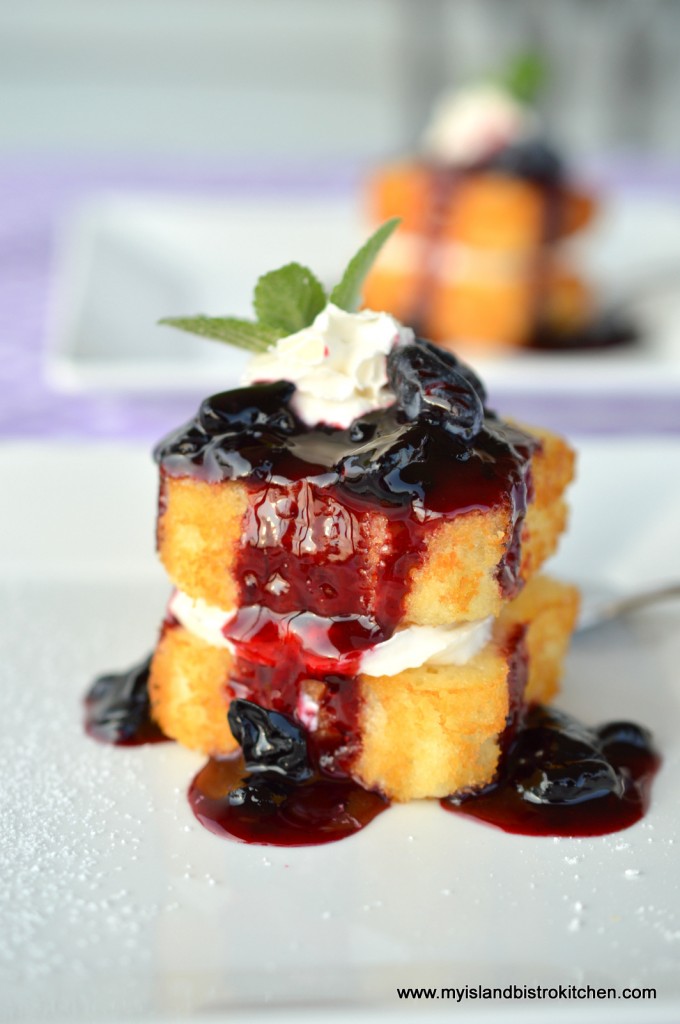
Thank you for visiting “the Bistro” today. There are lots of ways to connect with “the Bistro” through social media:
Join My Island Bistro Kitchen on Facebook.
Follow the Bistro’s tweets on twitter @PEIBistro.
Find the Bistro on Pinterest at “Island Bistro Kitchen”.
Follow along on Instagram at “peibistro”.
Rhubarb Custard Torte

Rhubarb Custard Torte is one of my all-time favorite desserts and it is simply sublime! While I freeze a substantial amount for use over the winter, there is nothing like scooting out to the garden to pick some fresh rhubarb just at the time I am making a recipe. However, our rhubarb season here in Atlantic Canada is all too short so most of my rhubarb recipes, including this torte, can be made with frozen rhubarb. Continue reading Rhubarb Custard Torte
Gingerbread
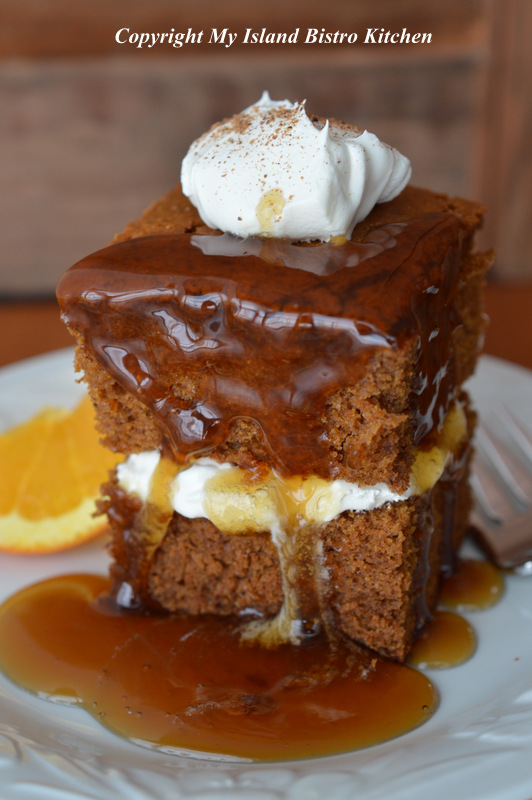
Do you have certain desserts that you associate with different seasons or times of the year? Gingerbread is one dessert I tend to associate most with the coldest winter months for some reason. It’s a plain but tasty dessert any time of the year but it’s a particularly good comfort food in the dead of winter. Continue reading Gingerbread
Chocolate Potato Cake
We are familiar with cakes made with vegetables like carrot and zucchini. However, have you ever heard of potato cake?
We Islanders like our spuds, there is no doubt about it. Potatoes are a very versatile vegetable and can be prepared and served in many different ways but have you ever heard of having them for dessert? Well, combine potatoes with chocolate and some light spice seasoning and you have a really tasty cake.
What follows is my creation of a recipe for chocolate potato cake. This is a fairly dense-textured cake so don’t look for it to have the same “foggy” and fluffy texture of a typical chocolate cake mix out of a box! Despite the two cups of sugar in the recipe, it is not overly or sickeningly sweet. The potatoes are cooked and mashed really well before adding them to the cake batter. It is important that they be lump-free as, otherwise, you will have lumps in the cake batter. The mashed potatoes should be warm when added to the batter.
You may find two or three of the ingredients different in this cake recipe. For example, I have added a pinch of cayenne pepper because I find it enhances the depth of the chocolate flavor. The key, of course, is not to overdo it – if you add too much, there will be excessive “heat” in the cake….just a pinch is all it takes. The addition of the espresso powder is also another good way to draw out the flavor of the cocoa and lend a mocha flavor to the cake. I have quite a collection of balsamic vinegars from our local Liquid Gold store here in Charlottetown. One of them is the dark chocolate balsamic vinegar which is delicious when simmered on the stove, reduced down, and drizzled over ice cream. If you have never tried a good quality balsamic vinegar reduction in this way, you are missing out on a delectable treat. I added 1/2 tbsp of this balsamic vinegar to the chocolate cake batter. This is a chocolate all-the-way cake!
I recommend baking this cake in a 10″ tube or bundt cake pan. These pans have a hollow tube in the center of the pan and this allows dense-batter cakes to rise and bake more evenly. There is also less chance of the cake falling in the middle or the outsides of the cake baking too quickly and drying out before the centre of the cake is baked.
The key to making this cake is not to overbake it. Start checking it at about the 40-45-minute baking point. If a cake tester does not come out clean at that point, continue to bake it but check it every 4-5 minutes. If it overbakes, it will be dry.
Chocolate Potato Cake
2½ cups flour
¼ tsp salt
2¾ tsp baking powder
¼ tsp soda
1 tsp cinnamon
¼ tsp allspice
pinch cayenne
⅔ cup cocoa
¾ cup butter
1 cup white sugar
1 cup brown sugar
3 eggs
1 cup warm mashed potatoes
½ cup milk
1½ tsp espresso powder dissolved in ⅓ cup hot water
2 tbsp Swiss Chocolate Almond Liqueur (or your favorite coffee liqueur)
½ tbsp dark chocolate balsamic vinegar (optional, but good)
1½ tsp vanilla
Method:
Assemble ingredients.
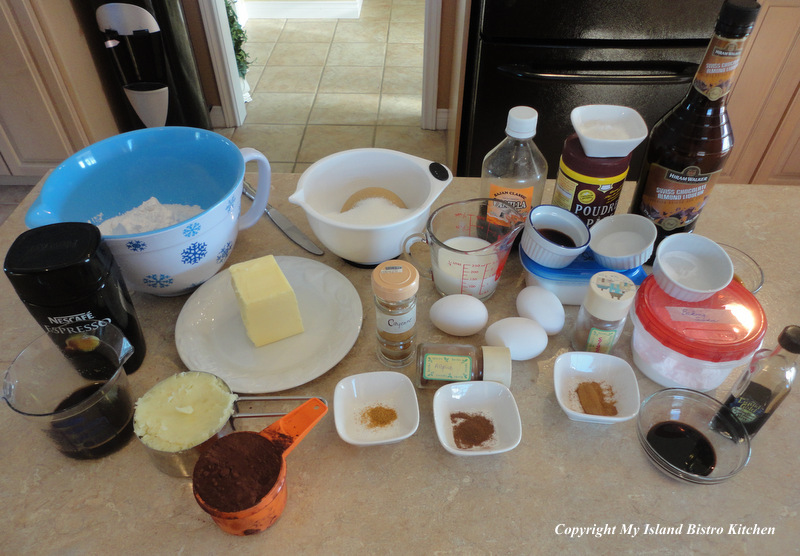
Preheat oven to 350°F.
Line bottom of 10” tube pan with parchment paper. Grease or spray cooking oil on sides of pan.
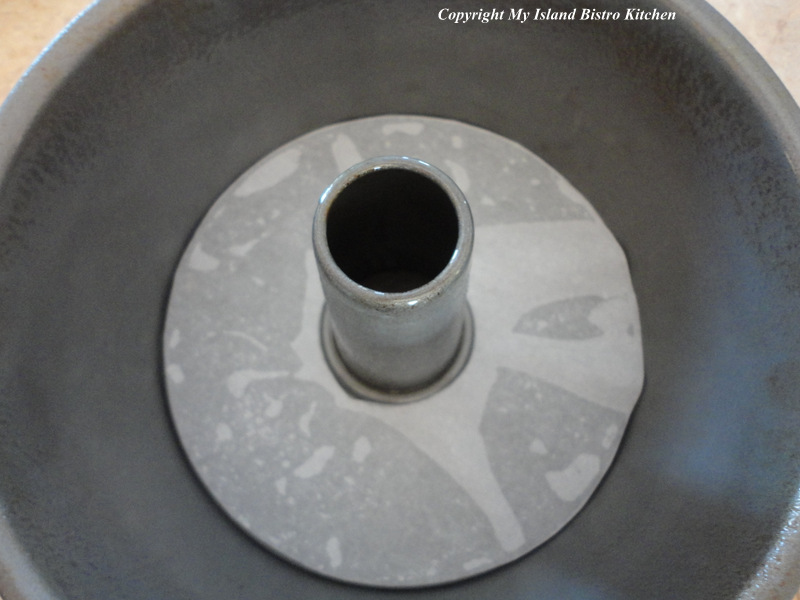
Sift or whisk together the flour, salt, baking powder, soda, cinnamon, allspice, cayenne, and cocoa. Set aside.
In separate bowl, combine the brown and white sugars.
In bowl of stand mixer, cream the butter and sugars until fluffy (2-3 mins on medium-high speed).
Add the eggs, one at a time and beat well to incorporate after each addition.
Add the mashed potatoes and beat on medium-high speed for 1-2 minutes until batter is smooth.
Add the coffee, liqueur, balsamic vinegar, and vanilla to the milk to make 1 cup of liquid. (Note – if you choose not to add the liqueur and/or balsamic vinegar, replace them with milk so that the liquid measurement equals 1 cup.)
Add the sifted dry ingredients alternately with the liquid ingredients, starting and ending with the flour mixture (process is three additions of dry ingredients to two of liquid), mixing well after each addition.
Scrape sides of bowl with spatula as necessary to ensure all ingredients are incorporated.
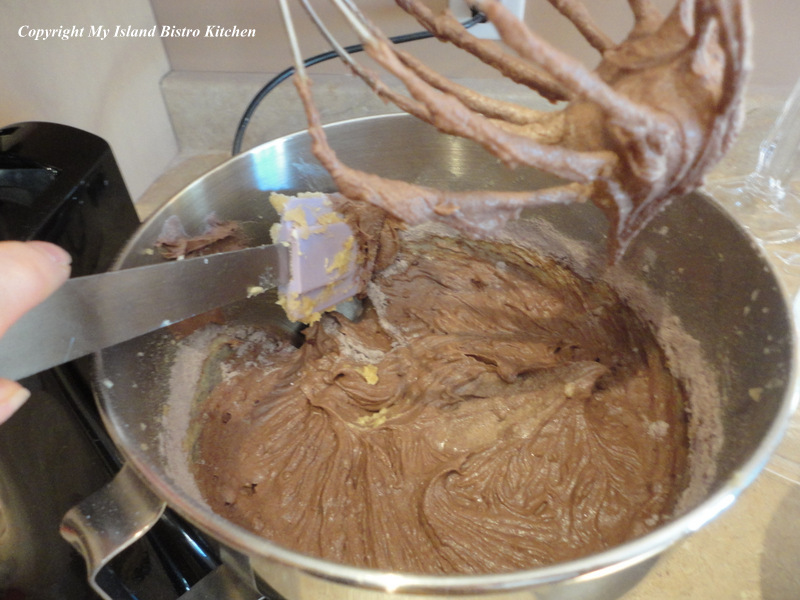
Pour batter into prepared tube pan.
Bake for apx. 40-55 minutes or until cake tester inserted in center of cake comes out clean and the cake springs back to a light touch. Do not overbake or cake will be dry.

Let cake cool in pan for 10 minutes then transfer to a wire rack to cool completely.
Ice with your favorite frosting.
Enjoy!
Pin Me to Pinterest!
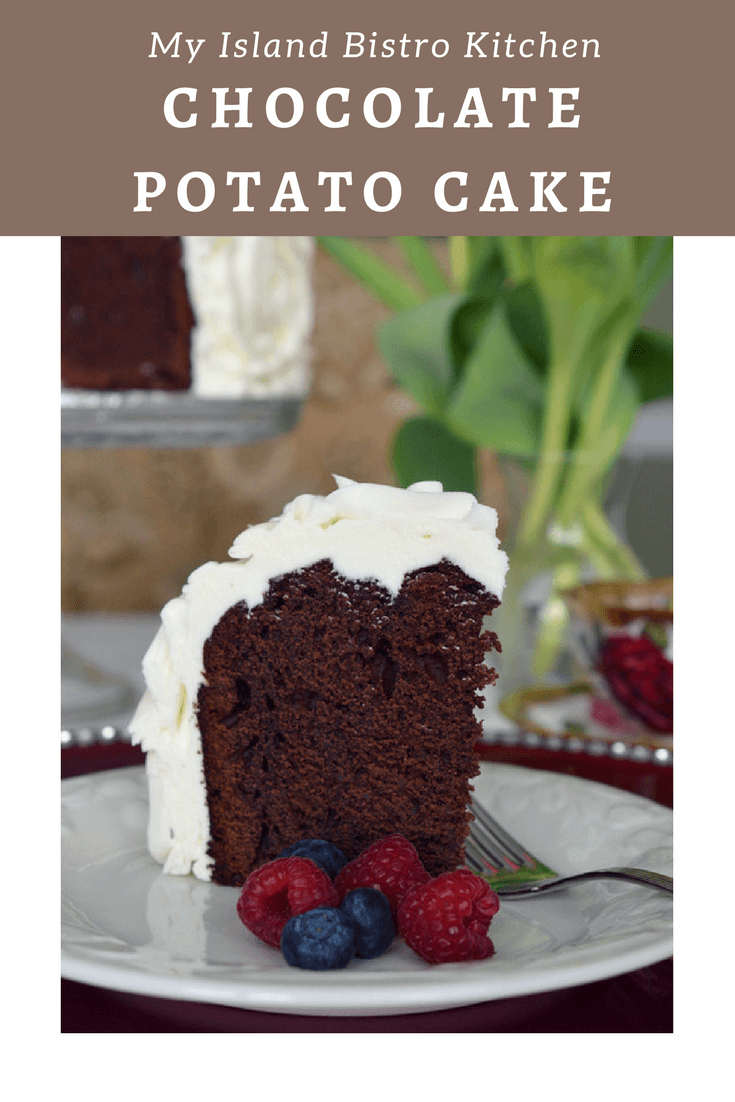
Thank you for visiting “the Bistro” today.
Be sure to visit my Facebook page at My Island Bistro Kitchen. You may also wish to follow me on twitter @PEIBistro, on Pinterest at “Island Bistro Kitchen”, and on Instagram at “PEIBistro”.
Blueberry Grunt
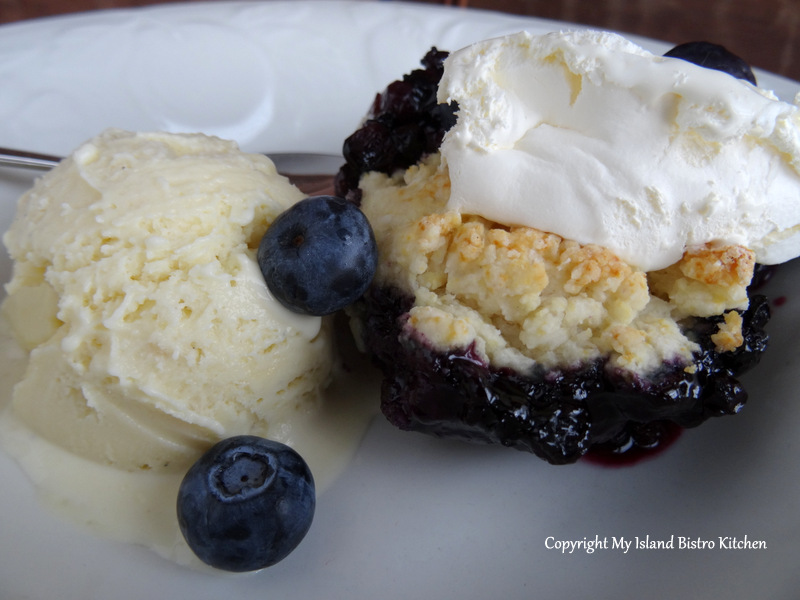
Do you ever have a craving for comfort foods? You know, the foods that are basic, nostalgic, or that you have a sentimental attachment to and that take you down memory lane. Some might even refer to these dishes as vintage. Maybe your mom made them for you when you were a child or you remember them from visits to grandma’s house. I’m talking about foods like macaroni and cheese, baked beans, scalloped potatoes, apple pie or crisp, homemade stews and “boiled dinners“, and baked bread. Cottage pie, rice pudding, roast chicken dinners, meatloaf with mashed potatoes, and fruit cobblers are other comfort foods commonly enjoyed in North American culture. There are many other dishes that bring us comfort, especially in the cold Canadian winters, so this list is not exhaustive and what constitutes comfort food may vary between cultures and regions of Canada.
These foods, in their traditional content, are by no means gourmet fare nor are they necessarily devoid of calories. They’re typically plain and simple stick-to-the-ribs kind of fare and they generate feelings of contentment and satisfaction … you feel warm and cozy when eating the meal. These kinds of dishes take basic, easy-to-find ingredients and are not usually difficult or complicated to make. They’re the kinds of foods that, when you walk into a home where they are being prepared, your appetite is immediately whetted and you harken back to early memories of enjoying those foods. They are hearty classics and endure over time, generation after generation. Yes, even the old tuna casserole is still considered a comfort food by many!
Today, I am sharing my recipe for Blueberry Grunt. I don’t know the origin of this dessert or how it got its name but it’s really just a baked fruit dessert – a slightly thickened fruit sauce on the bottom topped by a biscuit-like dumpling. This dessert is often made on the stove top where the dumplings are put in the pot on top of the bubbling blueberry sauce, covered and let simmer for about 15 minutes. However, my recipe calls for the dessert to be baked in the oven.
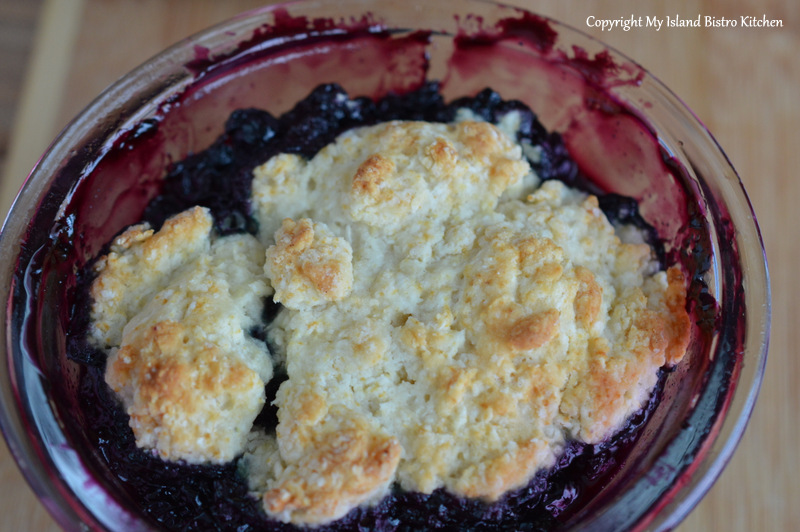
My featured Island product in this recipe are the blueberries. Each summer, I pack away several bags of these sweet little Island-grown morsels for use in my favorite recipes like this one for Blueberry Grunt.
[Printable recipe follows at end of posting]
Blueberry Grunt
Ingredients:
4 cups blueberries, fresh or frozen
1/2 cup white sugar
2 tbsp brown sugar
1 tbsp + 1 tsp cornstarch
2 tsp lemon juice
1 1/2 tsp grated lemon rind
1/2 cup water
1/2 tsp cinnamon
1/4 tsp nutmeg
1/8 tsp cardamon
Topping:
2 cups flour
4 tsp baking powder
1/4 tsp salt
2 1/2 tbsp white sugar
1 cup milk
2 1/2 tbsp cold butter
Method:
Preheat oven to 400F.
In a small bowl, mix together the sugars, cornstarch, and spices. Stir in the grated lemon rind. Set aside.
In saucepan, combine blueberries and the sugar mixture. Add the lemon juice and water. Bring to a boil then reduce heat and simmer mixture for 5-6 minutes. Remove from heat.
Meanwhile, in a large bowl, combine flour, baking powder, salt and sugar. Cut in cold butter until mixture resembles coarse oatmeal. Add enough milk to make a soft dough mixture that will cling together.
Grease a 1 1/2 or 2-quart baking dish or 8 individual ramekins. Spoon the blueberry mixture into baking dish(es).
Divide the dumpling dough into 8 portions.
Place dumplings over blueberry mixture (close together if baking in one casserole or centered if using individual dishes).
Bake in 400F oven for about 20-25 minutes or until dumplings are done and lightly golden brown on top.
Serve hot or warm with a dollop of whipped cream or vanilla ice cream (or both!).
Serves: 8
What are your favorite comfort foods?
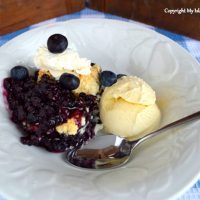
Blueberry Grunt
Ingredients
Blueberry Base:
- 4 cups blueberries, fresh or frozen
- 1/2 cup white sugar
- 2 tbsp brown sugar
- 1 tbsp + 1 tsp cornstarch
- 2 tsp lemon juice
- 1 1/2 tsp grated lemon rind
- 1/2 cup water
- 1/2 tsp cinnamon
- 1/4 tsp nutmeg
- 1/8 tsp cardamom
Topping:
- 2 cups flour
- 4 tsp baking powder
- 1/4 tsp salt
- 2 1/2 tbsp white sugar
- 1 cup milk
- 2 1/2 tbsp cold butter
Instructions
- Preheat oven to 400F.
- In a small bowl, mix together the sugars, cornstarch, and spices. Stir in the grated lemon rind. Set aside.
- In saucepan, combine blueberries and the sugar mixture. Add the lemon juice and water. Bring to a boil then reduce heat and simmer mixture for 5-6 minutes. Remove from heat.
- Meanwhile, in a large bowl, combine flour, baking powder, salt and sugar. Cut in cold butter until mixture resembles coarse oatmeal. Add enough milk to make a soft dough mixture that will cling together.
- Grease a 1 1/2 or 2-quart baking dish or 8 individual ramekins. Spoon the blueberry mixture into baking dish(es).
- Divide the dumpling dough into 8 portions.
- Place dumplings over blueberry mixture (close together if baking in one casserole or centered if using individual dishes).
- Bake for about 20-25 minutes or until dumplings are done and lightly golden brown on top.
- Serve hot with a dollop of whipped cream or vanilla ice cream (or both!).
Recipe Notes
Yield: 8 servings
[Copyright My Island Bistro Kitchen]
If you have made this recipe and enjoyed it and/or wish to share it with your friends and family, please do so on social media but be sure to share the direct link to this posting from my website.
Connect with My Island Bistro Kitchen on Social Media
Join the Facebook page for My Island Bistro Kitchen: https://www.facebook.com/MyIslandBistroKitchen/
Follow “the Bistro” on “X” (formerly Twitter): https://twitter.com/PEIBistro/
See the drool-worthy gallery of mouth-watering food photos from My Island Bistro Kitchen on Instagram: https://www.instagram.com/peibistro/
Follow “the Bistro” on Pinterest at https://www.pinterest.ca/peibistro/ and pin the Pinterest-ready photo found at the end of this post to your favorite Pinterest boards.
You may also enjoy these other blueberry dessert recipes from My Island Bistro Kitchen:
Blueberry Buckle
Blueberry Bread Pudding
Blueberry Cream Cheese Pie
Peach Blueberry Crisp
Mini Blueberry Bundt Cakes
Orange-scented Blueberry Oat Square
PIN ME TO PINTEREST!
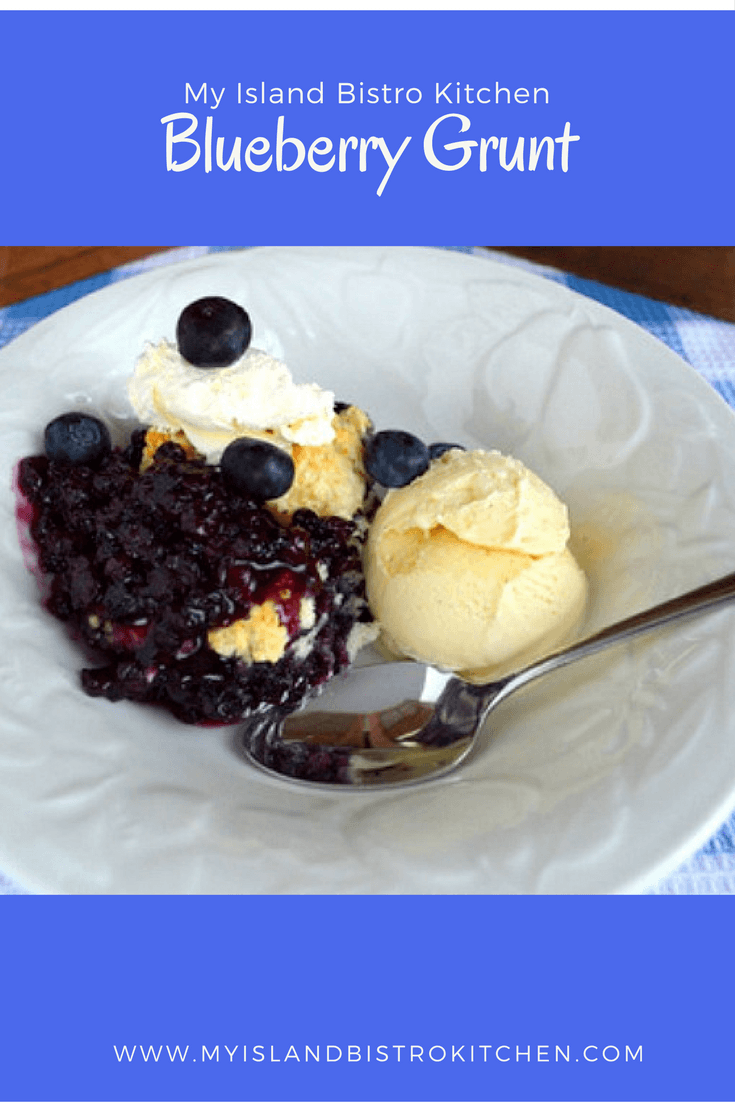
Plum Pudding Recipe and Symbolism
Today’s posting is all about plum pudding, or as some refer to it simply as the Christmas pudding, the traditional Christmas dinner dessert in many Prince Edward Island households. Continue reading Plum Pudding Recipe and Symbolism
Glazed Strawberry Pie
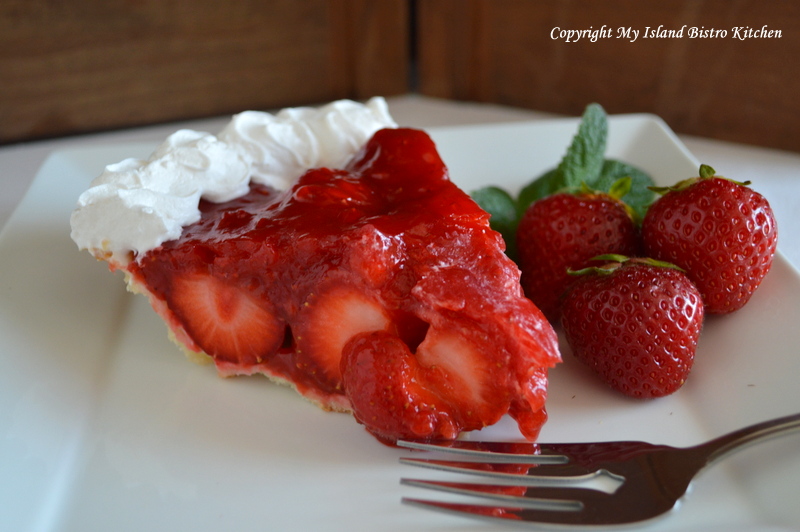
There are so many things I like about summer in Prince Edward Island but one of my very favorite things is glazed strawberry pie made with fresh, local Island berries. After I have had a couple of “feeds” of plain berries, sugar, and milk, I am ready for them in other recipes. One of those recipes always has to be fresh strawberry pie.
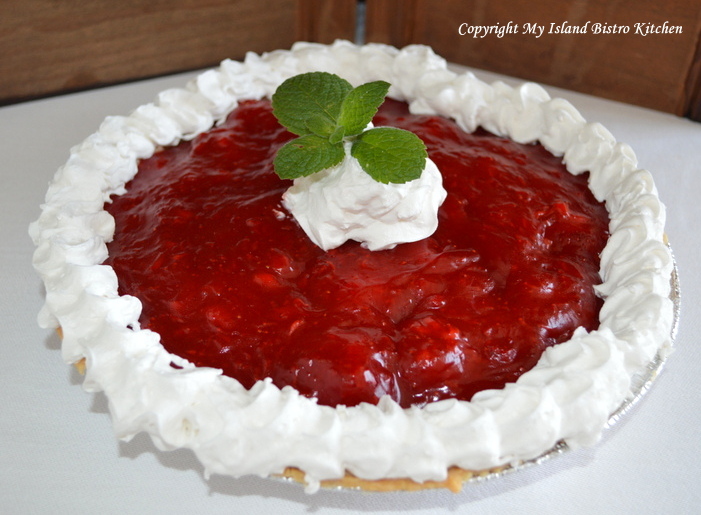
The strawberry pie recipe below is the one my family has used for decades. I have no idea what prompted us to start making strawberry pie or where the recipe came from. I just know it has been around for a good long time and I have yet to find any other that matches or beats it.
To make this pie, you will need the freshest strawberries possible and ones that are not overly ripe. A slightly firm variety of berry is best.
A single 9″ baked pie crust will be needed for this recipe. For hints, tips, and a recipe for pie pastry, click here.
Ingredients:
Apx. 1 1/4 – 1 1/2 qts fresh strawberries, hulled, washed, and dried
2 tbsp cornstarch
3/4 cup sugar
1/8 tsp salt
1 tbsp butter
1 tsp lemon juice
1 – 9″ baked pie shell
Directions:
Hull, wash, and dry strawberries (use a paper towel to gently blot the berries dry). Set aside enough to cover the bottom of the pie crust.
Cut up berries to prepare them for crushing – it’s hard to say exactly how many because berries vary in size and water content. Start with a few berries at a time.
Using a potato masher, crush enough strawberries to make 1 1/2 cups.
Assemble all ingredients.
In medium-sized saucepan, combine cornstarch, sugar, and salt. Mix well. Add crushed berries and stir to blend well.
Place mixture over medium heat and stir constantly until it becomes somewhat clear and it starts to thicken, about 5-7 minutes. Watch that mixture does not scorch as this can easily and quickly happen.
Reduce heat to low, cover mixture, and continue to cook for 5 minutes, stirring occasionally to prevent mixture from sticking to pan. Remove from heat. Add butter and lemon juice. Stir well.
Arrange whole strawberries in baked pie shell. If necessary, fill in any gaps between berries with a few cut-up berries.
Spoon hot glaze mixture over the berries.
Completely cover berries with the glaze.
Place pie in refrigerator and let chill several hours (at least 3 hrs) before serving. Add whipped cream at time of serving and decorate with additional berries as desired.
Yield: Apx. 8 servings
Tips and Notes: This pie is best served the day it is made as the pie crust tends to become somewhat soggy the next day. Leaving the berries whole helps contain the amount of moisture that soaks into the pie crust as cutting the berries up releases their juices and lessens the lifespan of the pie crust.
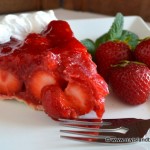
Glazed Strawberry Pie
Ingredients
- Apx. 1 1/4 - 1 1/2 qts fresh strawberries, hulled, washed, and dried
- 2 tbsp cornstarch
- 3/4 cup granulated sugar
- 1/8 tsp salt
- 1 tbsp butter
- 1 tsp lemon juice
- 1 - 9" baked pie shell
Instructions
- Hull, wash, and dry strawberries (use a paper towel to gently blot the berries dry). Set aside enough whole berries to cover the bottom of the pie crust.
- One and one-half cups of crushed berries will be needed for the glaze. Cut up berries to prepare them for crushing - it's hard to say exactly how many will be required because berries vary in size and water content. Start with a few berries at a time. Using a potato masher, crush enough strawberries to make 1 1/2 cups.
- In medium-sized saucepan, combine cornstarch, sugar, and salt. Mix well. Add the crushed berries and stir to blend well.
- Place mixture over medium heat and stir constantly until it becomes somewhat clear and it starts to thicken, about 5-7 minutes. Watch that mixture does not scorch as this can easily and quickly happen.
- Reduce heat to low, cover mixture, and continue to cook for about 5 minutes, stirring occasionally to prevent mixture from sticking to pan. Remove from heat. Add butter and lemon juice. Stir well.
- Arrange the whole strawberries in baked pie shell. If necessary, fill in any gaps between berries with a few cut-up berries.
- Spoon hot glaze mixture over the berries. Completely cover berries with the glaze.
- Place pie in refrigerator and let chill several hours (at least 3 hrs) before serving. Add whipped cream at time of serving and decorate with additional whole berries, if desired.
Recipe Notes
Yield: Apx. 6-8 servings
Tips and Notes: This pie is best served the day it is made as the pie crust tends to become somewhat soggy the next day. Leaving the berries whole helps contain the amount of moisture that soaks into the pie crust as cutting the berries up releases their juices and reduces the lifespan of the pie crust.
Thank you for visiting “the Bistro” today. There are lots of ways to connect with “the Bistro” through social media:
Join My Island Bistro Kitchen on Facebook
Follow the Bistro’s tweets on twitter @PEIBistro
Find the Bistro on Pinterest at “Island Bistro Kitchen”
Follow along on Instagram at “peibistro”
Belgian Waffles with Strawberries
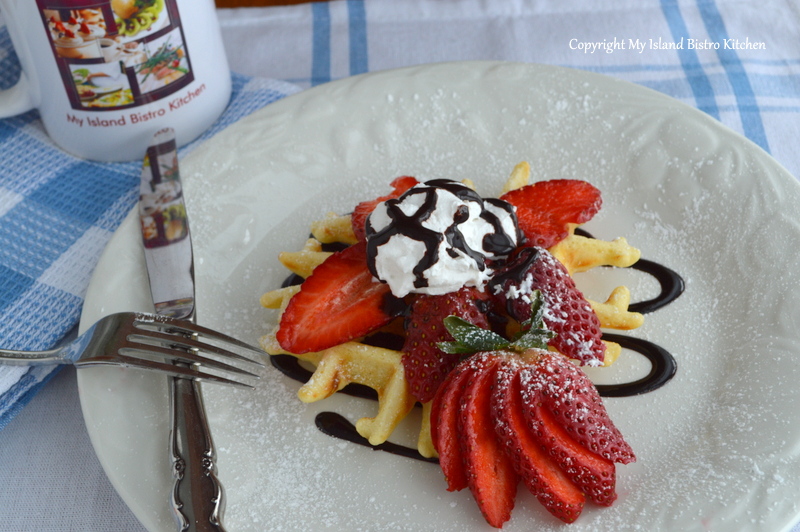
The first time I had Belgian waffles was in Ogunquit, Maine, a long time ago. We used to vacation there and we found a wonderful little café that opened only for breakfast and their specialty was the Belgian waffle served with huge, fresh Maine blueberries. Naturally, a Belgian waffle maker had to be purchased so we could make them at home because waffles are, in fact, quite easy to make and just take standard baking ingredients!
Waffles are very versatile. They can be a breakfast food, eaten at brunch, lunch, for dessert or even as a main course for dinner, depending on the topping. There is nothing like creamed chicken atop a puffy Belgian waffle for good old-fashioned comfort food!
I love fresh berries, especially strawberries and blueberries, on waffles. Good drizzled with pure maple syrup, a rich chocolate sauce is also an option and a real treat for waffles. So, why not take a lowly basic waffle and dress it up for a tasty meal at any time of day.
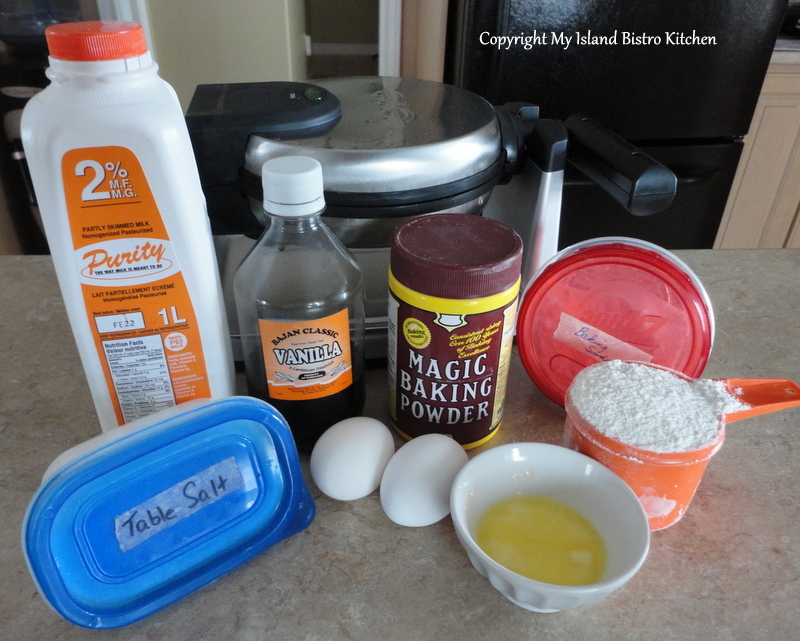
Belgian Waffles
Ingredients:
1 cup all-purpose flour
1/2 tbsp baking powder
1/4 tsp baking soda
pinch salt
1 cup milk
1/2 tsp vanilla
2 medium-sized eggs, separated
2 tbsp melted butter
Separate the eggs. Beat the egg whites stiff. Set aside.
In separate bowl, mix the egg yolks and all remaining ingredients.
With electric mixer, beat until well-blended.
Gently fold the egg whites into the flour and milk mixture. Fold just until they are incorporated. This will yield a light, fluffy waffle.
Heat waffle maker and cook waffles according to manufacturer’s directions.
To serve, add sliced fruit, a dollop of whipped cream, and drizzle with your favorite syrup or topping. Dust with confectioner’s sugar, if desired.
Yield: Apx. 3-4 waffles
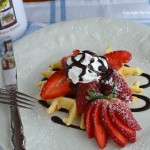
Belgian Waffles
Ingredients
- 1 cup all-purpose flour
- 1/2 tbsp baking powder
- 1/4 tsp baking soda
- pinch salt
- 1 cup milk
- 1/2 tsp vanilla
- 2 medium-sized eggs, separated
- 2 tbsp melted butter
Instructions
- Separate the eggs. Beat the egg whites stiff. Set aside.
- In separate bowl, mix the egg yolks and all remaining ingredients. With electric mixer, beat until well-blended.
- Gently fold the egg whites into the flour and milk mixture. Fold just until they are incorporated. This will yield a light, fluffy waffle.
- Heat waffle maker and cook waffles according to manufacturer's directions.
- To serve, add sliced fruit, a dollop of whipped cream, and drizzle with your favorite syrup or topping. Dust with confectioner's sugar, if desired.
Recipe Notes
Yield: Apx. 3-4 waffles
[Copyright My Island Bistro Kitchen]
If you have made this recipe and enjoyed it and/or wish to share it with your friends and family, please do so on social media but be sure to share the direct link to this posting from my website.
Connect with My Island Bistro Kitchen on Social Media
Join the Facebook page for My Island Bistro Kitchen: https://www.facebook.com/MyIslandBistroKitchen/
Follow “the Bistro” on “X” (formerly Twitter): https://twitter.com/PEIBistro/
See the drool-worthy gallery of mouth-watering food photos from My Island Bistro Kitchen on Instagram: https://www.instagram.com/peibistro/
Follow “the Bistro” on Pinterest at https://www.pinterest.ca/peibistro/ and pin the Pinterest-ready photo found at the end of this post to your favorite Pinterest boards.
PIN ME TO PINTEREST!
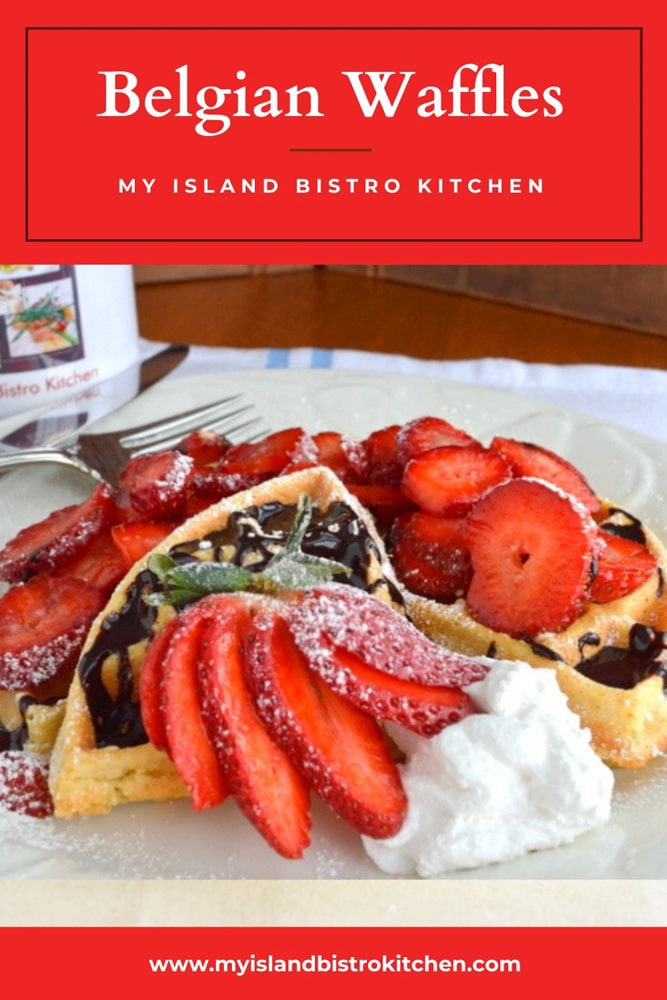
War Cake – A Part of Wartime Culinary History
![Remembrance Day Service at the Cenotaph in front of Province House, Charlottetown, PEI, Canada [11 November 2012]](https://myislandbistrokitchen.com/wp-content/uploads/2012/11/1-DSC07462.jpg)
Those of us who have been fortunate enough never to have known or experienced war have opportunities to demonstrate our respect and gratitude for, and remembrance of, these acts of bravery and sacrifice. For example, we wear a poppy on the left breast, close to the heart to signify remembrance of the lives lost.

Thousands of people across the country will attend Remembrance Day ceremonies in their local communities where they will respectfully observe a moment’s silence at 11am on the 11th day of the 11th month to mark the time the Armistice was signed to end WWI. Wreaths will be laid in commemoration.

One of the most well-known poems about war was written in May, 1915, by Lt. Col. John McCrae, a Canadian Medical Officer in WWI. While stationed near Ypres, Belgium, where some of the most horrific and bloodiest fighting of WWI occurred, he was motivated to write about the death he saw around him and of the prolific red poppies growing amidst the devastation of war in the Flanders area of western Belgium. His poem, “In Flanders Fields” has become synonymous with Remembrance Day in Canada and Lt. Col. McCrae is often credited with being the catalyst that led to the poppy being identified as the symbol of remembrance of the blood shed by soldiers who were casualties of battle.

On this Remembrance Day, I am going to focus my food blog feature story on war cake, a wartime dessert that is still made and served in several Island households today.
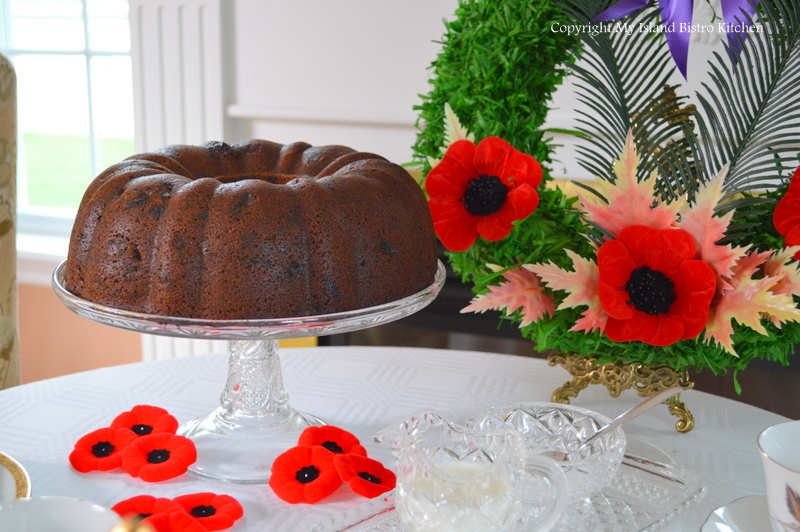
As a small child I well remember my grandmother making war cake and this was long after WWII had ended. I loved her war cake! It is such a simple raisin-spice cake that is characterized by the absence of eggs and milk — ingredients that would have been scarce during wartime. This cake is sometimes referred to as “boiled raisin cake” because raisins form the main content and the majority of the ingredients are boiled, then cooled, before they are mixed with flour and baking soda and then baked in the oven. Because of food shortages during war time, many foods were rationed.
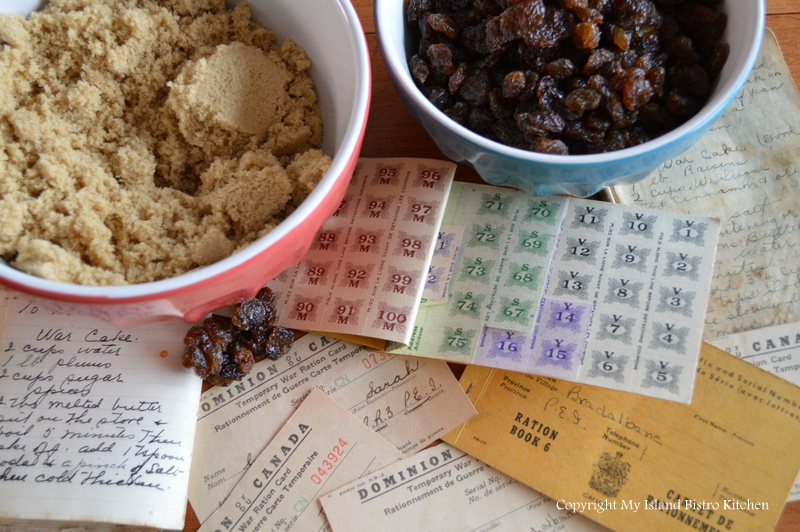
Born of necessity, homemakers during wartime became resourceful, frugal, adaptable, and creative in order to feed their families. Cooking tended to be very basic. Women were known to have saved their ration stickers so they could buy the raisins and sugar that the war cake recipe called for – thus war cake would have been a very prized commodity.
War cake was made for consumption on the home front but many also made the cakes in tin cans and packed them in socks, mittens, and underwear they were shipping overseas for their loved ones serving in the war. Imagine the excitement when a soldier would have received this package from home and discovered a mother’s or sister’s war cake inside! Amazingly, with the slow mail and ship service during WWI and WWII, there is evidence these cakes were received as the soldiers would refer to them in their letters home, letters that would have looked much like the July 7, 1914, letter in the photograph below.
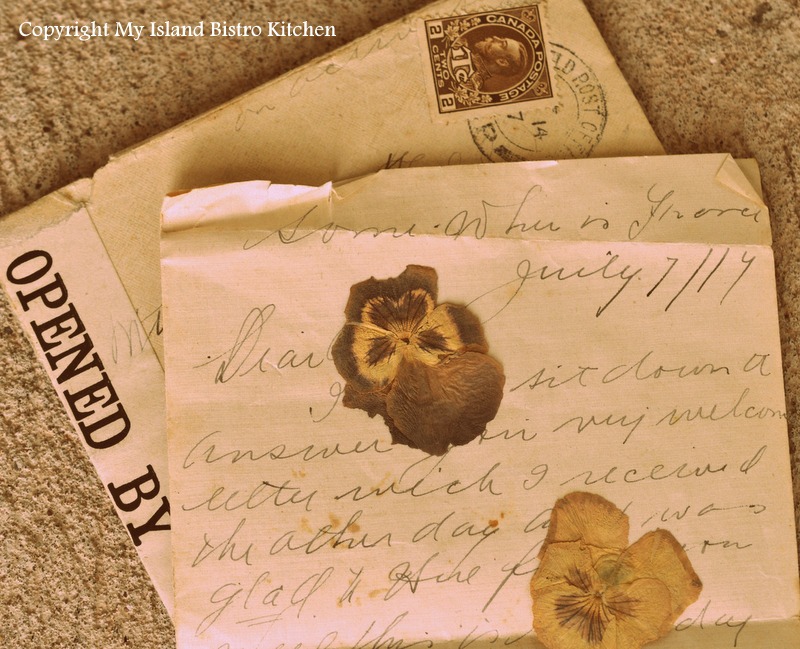
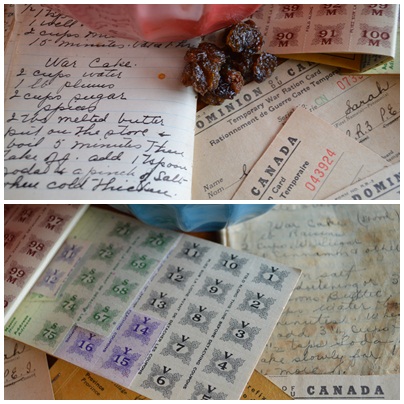
In my research for this story, I examined many recipes for war cake and found similarities amongst them all. Some were very sketchy in terms of amount of ingredients to be put in the batter and many were almost totally devoid of any directions. While the amounts of the ingredients may vary slightly, all of the recipes I reviewed were essentially the same in ingredient content. All called for big, sticky raisins (you may know these as “Lexia” raisins), a variety of spices of the cook’s choice, either brown or white sugar or a combination of both, shortening or lard, boiling water, flour, and soda. One thing I noted was the significant amount of sugar that the recipes called for – i.e., two cups per cake. Sugar was one item that was commonly rationed during wartime and a cake taking two cups of sugar would certainly have been considered a luxurious dessert, I am sure. Flavour may vary from cake to cake based on spices used in the batter. The choice of spices varies but typically consisted of cinnamon, nutmeg, and cloves, as a minimum, with ginger frequently appearing in recipes. I added mace and cardamom to my cake to give it a bit more flavour (recipe follows at end).
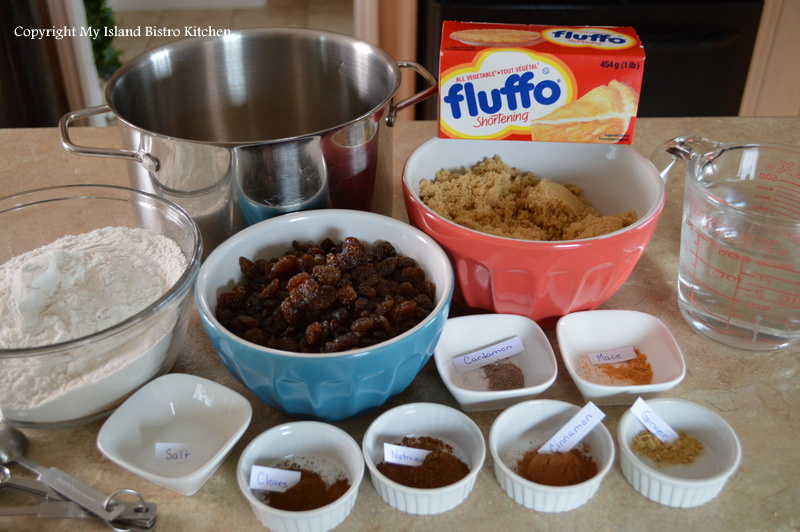
I am told these cakes were often made with lard (as opposed to butter) for a couple of reasons. First, lard has a longer shelf life than butter would have had and, for cakes being sent overseas to the soldiers, it would have been a long journey for the cakes to reach Europe so shelf life of the cakes was an important factor. Second, butter was often scarce during wartime because there were no big herds of cattle on local farms so butter would have been used sparingly, even for those living on farms and churning their own. Lard, on the other hand, would have been much more readily available, particularly on farms. I found a couple of recipes that indicated either butter or shortening could be used in the recipe; however, butter was called for in a much lesser quantity than the shortening, if the latter was used instead. For example, I found one recipe that called for 2 tablespoons of butter or 1 cup of shortening which demonstrates how judiciously butter would have been used, if at all.
While its ingredients are simple, war cake takes some time to make. All of the ingredients, except the flour and soda, are boiled on the stove for 5 minutes. Then it is important to let the boiled raisin mixture cool to room temperature as the mixture will thicken naturally on its own as it cools. This will normally take 4-5 hours. If the flour and soda are added into a mixture that is too hot, the result is likely to be a gummy cake. When the raisin mixture is cooled, the flour and soda are stirred in and the mixture turned into the baking pan. My grandmother made her war cake in a loaf pan; however, traditionally, war cake seems to have been made in some kind of a round pan – usually a tube pan or, in the case of overseas shipping during war time, in tin cans. War cake is a very dense cake which makes it sometimes difficult to get the center of the cake baked without drying out the outside edges. It is also a heavier type cake which makes it somewhat prone to falling in the center. A tube (or Bundt pan, if you have one) removes the baking uncertainty and helps the cake to bake more evenly.
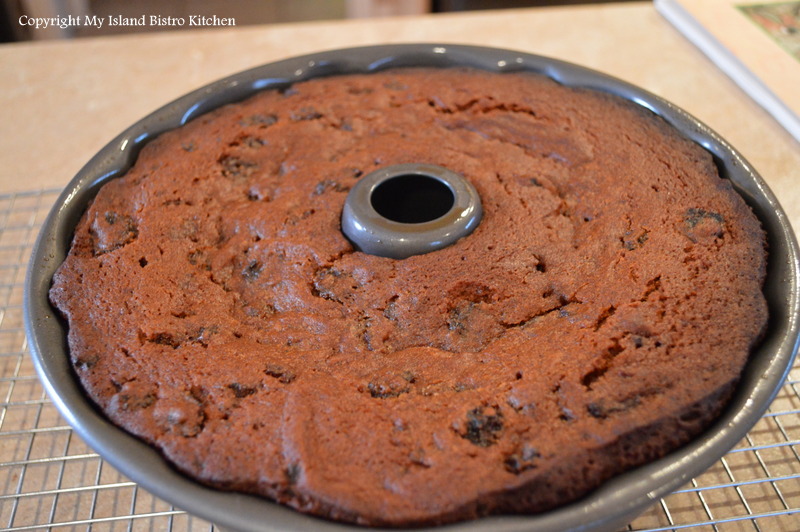
War cakes take, on average, about an hour to bake. The old recipes I reviewed didn’t even mention baking the cake let alone at what temperature (in fact, one recipe simply said “to thicken” but didn’t elaborate on what thickening agent was to be used!). These recipes predate our modern electronic ovens! While some suggest baking the cake at 350F, I thought that might be a bit high so I baked my war cake at 335F for one hour. Because there are no eggs or milk in the cake for moistness, it is very easy to overbake the cake and end up with a dry product. Hence, it is important to time the baking carefully and to use a cake tester starting at about the 45-minute point. If the cake starts to darken on the top or edges too quickly, simply place a piece of tin foil loosely over the top. Adding a small pan of water to the lower shelf in the oven while baking the cake will also help to keep the cake moist.
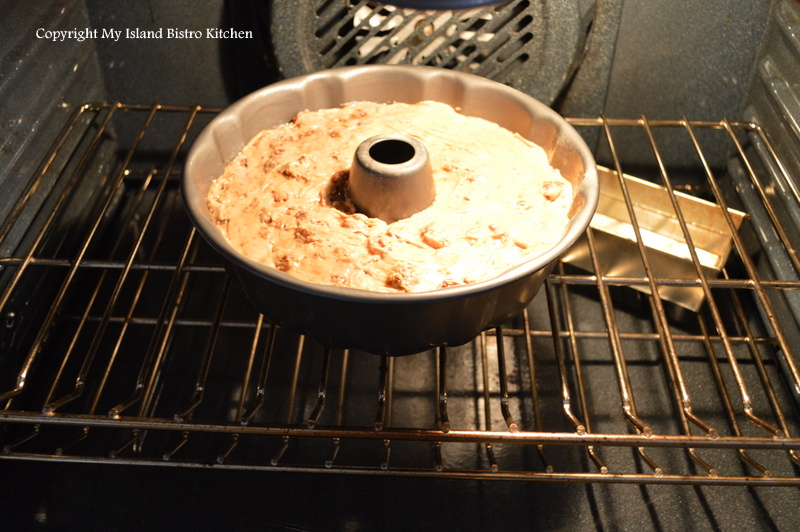
Because of the texture of the cake, it may seem soft on the top and not baked; however, if a cake tester comes out of the cake clean, it’s time to remove it from the oven before it dries out.
War cake is a “stick to the ribs” substantial, hearty kind of cake. It goes particularly well with a nice cup of tea.
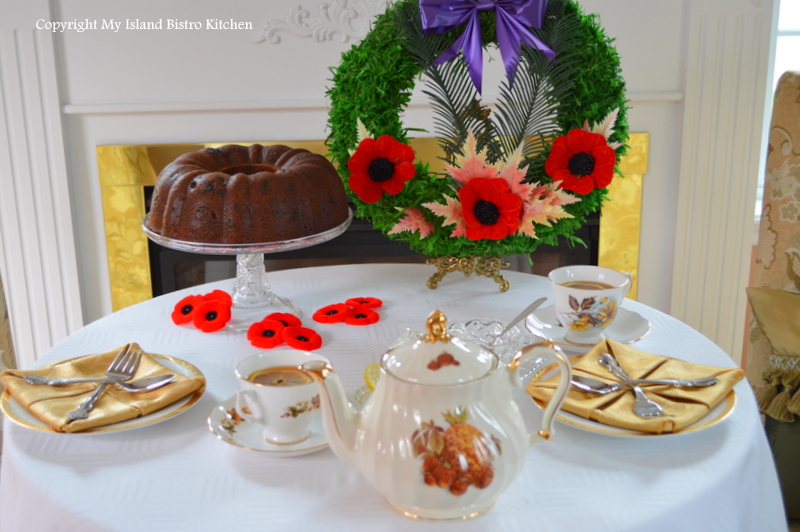
In keeping with the traditional way war cake was served, I have photographed the cake plain, just as it would have been eaten during wartime.
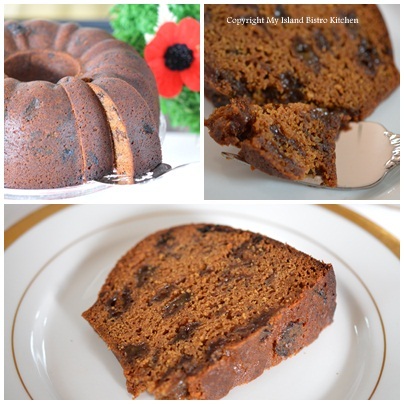
War cake was not traditionally iced. However, it would be lovely served with a dollop of whipped cream or vanilla or maple ice cream. It could also be dressed with a brown sugar sauce or, to make a plain cake really decadent, why not serve all three – ice cream, brown sugar sauce, and whipped cream!
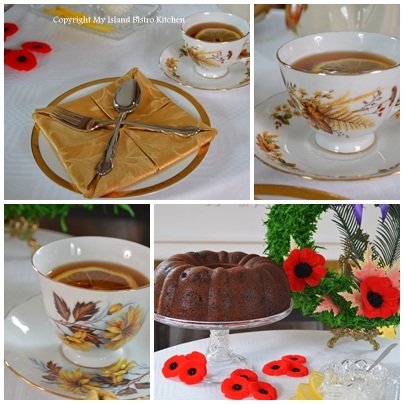

Regardless where you are in the world, if you have any wartime memories (either your own or those passed down to you from your ancestors) of war cake made for consumption on the home front or to send to the soldiers fighting the war, I would love to hear about them. War cake is a part of wartime culinary history.
Here are some photographs of the Remembrance Day Ceremony at the cenotaph in downtown Charlottetown, PEI, this morning.
![Remembrance Day in Charlottetown, PEI [11 November 2012]](https://myislandbistrokitchen.com/wp-content/uploads/2012/11/1-Parade.jpg)

![Hon. Robert W.J. Ghiz, Premier of the Province of Prince Edward Island lays a wreath on behalf of the people of the Island at the Remembrance Day Service in Charlottetown, PEI [11 November 2012]](https://myislandbistrokitchen.com/wp-content/uploads/2012/11/1-Premier-Ghiz.jpg)
![Small Child Watches as a Veteran lays a Wreath at the Remembrance Day Service in Charlottetown, PEI ]11 November 2012]](https://myislandbistrokitchen.com/wp-content/uploads/2012/11/1-Joyce-Paynter-and-Child.jpg)

![Veterans Laying Wreaths at Remembrance Day Service in Charlottetown, PEI [11 November 2012]](https://myislandbistrokitchen.com/wp-content/uploads/2012/11/1-Veterans-Laying-Wreaths.jpg)

![Canada Flag Flies at Half-Mast on Remembrance Day, Charlottetown, PEI [11 November 2012]](https://myislandbistrokitchen.com/wp-content/uploads/2012/11/1-Flag-and-wreaths.jpg)
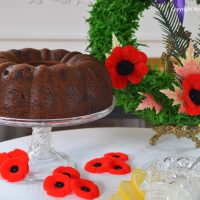
War Cake
Ingredients
- 3/4 cup shortening
- 2 cups brown sugar, lightly packed
- 1 pound large, sticky raisins
- 1 tsp salt
- 1 tsp cinnamon
- 1 tsp nutmeg
- 1/2 tsp cloves
- 1/4 tsp ginger
- 1/8 tsp mace
- 1/8 tsp cardamon
- 2 cups boiling water
- 3 cups all-purpose flour
- 2 tsp soda
Instructions
- Assemble ingredients.
- Place the shortening, brown sugar, raisins, salt, spices, and boiling water into a large saucepan. Over medium-high heat, bring mixture to a boil. Reduce heat to medium or slightly lower and boil mixture for five minutes. Remove from heat and set saucepan on cooling rack. Let mixture cool to room temperature (4-5 hours), stirring occasionally.
- In bowl, whisk the flour and baking soda together. Set aside.
- Grease large tube or Bundt pan.
- When raisin mixture has cooled completely, add the flour and baking soda. Stir until dry ingredients have been completely mixed into the raisin mixture.
- Spoon mixture into greased pan. Add a small pan of hot water to lower shelf in oven for moisture while cake is baking. Bake cake on middle rack in 335°F preheated oven. If cake starts to brown on the top too quickly, loosely place a piece of tin foil on top of cake. Bake apx. 1 hour but begin to test cake for doneness, using a cake tester, at the 45-minute point as cake can dry out very quickly.
- Remove cake from oven and place pan on cooling rack for 10 minutes then remove from pan. Allow cake to cool completely before cutting.
Recipe Notes
[Copyright My Island Bistro Kitchen]
Lavender – The Trendy New Culinary Herb
Okay, so I must admit the thought of baking and cooking with something I have always considered a perfume can be a bit daunting but with lavender being the trendy new culinary herb, I thought why not be a bit venturesome. But can I use just any lavender for culinary purposes? To find out, I paid a visit to The Five Sisters of Lavender Lane – aptly named because there are five sisters involved with the growing, harvesting, and production of the lavender products.
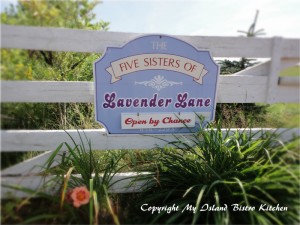
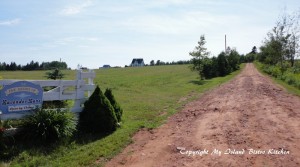
Through the scenic rolling hills of Kelly’s Cross in rural PEI, on the Island’s South side, I find PEI’s only lavender farm. In 1999, Carol Cook bought the farm and, in 2001, planted her first 100 lavender plants to see how they would ‘weather the winter’ on the Island. They did well and, today, there are over an estimated 3000 plants of two varieties (Hidcote and Munstead) grown on the farm.

Carol tells me that starting lavender from seed is not necessarily a guarantee of success. Instead, her preference is to start new plants by propagating from cuttings. This is where a long stem of lavender attached to the mother plant is buried under some soil and left to grow its own roots. The following year it can be cut from the mother plant and, voila, a new lavender plant is started. Another option is to take a cutting from a plant, cut it on an angle, dip it in a root boost starter product, and place it in a sandy soil mixture to take root.
Most of us know lavender as a perfume and potpourri product. However, lavender is actually an herb of the mint family and certain varieties of it are known as culinary herbs. These are primarily the Hidcote and Munstead varieties. Lavender is often considered to be similar to thyme, rosemary, and sage and it can, in fact, be substituted for rosemary in many recipes. If you have ever cooked with Herbes de Provence, chances are you have already tasted lavender since it is a common ingredient in this herb mix along with the typical mixture of thyme, rosemary, and savory.
Lavender is one of the more aromatic herbs and some say it bears citrus notes or even a hint of pine. The lavender buds (the stage just before the plants blossom into full open flower) possess a higher oil content and have the most intense taste. They tend to have a stronger, minty flavour and, when used in cooking or baking will be more pungent and have “more bite” to them. When crushed or ground, the lavender buds have a sweeter, milder flavour. While the leaves, stems, buds, and flowers can all be used for culinary purposes, the flower buds are said to give the most flavour.
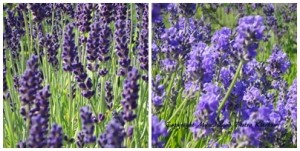
In PEI, harvesting of lavender occurs in mid-July. When at their bud stage, the beautiful purple/mauve buds are removed from their tall spikes, washed, and spread on screens to dry. They are then ready to be used in various products. It is possible to get a second, smaller harvest from the same plants late in August or early September. The photographs below were taken at the lavender farm on July 10, 2012, the day before they began harvesting. I can only imagine the wonderful scent there must have been during the harvesting process!
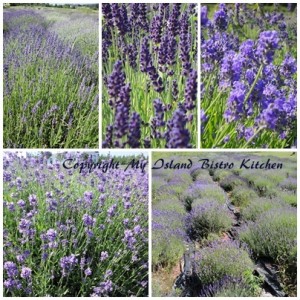
The Five Sisters of Lavender Lane only sell their culinary lavender in the small gift shop at their farm in Kelly’s Cross and it is not uncommon for local chefs to stop by to pick up their supply for their restaurants. If you are cooking with lavender, just make sure that it is the culinary variety you are using and that it has been grown organically, pesticide-free. Besides the culinary lavender, the farm also produces and sells a number of other lavender products onsite including perfumed products. This year, they are currently experimenting with the production of lavender extract which can be used in culinary products in the same way that vanilla, almond, or lemon extract is used.
Lavender is a strong herb so my advice is less is more and to exercise caution in the amount you use in a recipe. If you use too much, it will not be a pleasant taste because it may seem like you are eating soap or that you used perfume in the dish. I find a lot of recipes call for 1-2 tablespoons of lavender and that is way too excessive in any recipe for my taste. When trying a recipe with lavender, I start with a very modest amount and, if I find it is not enough, I will slightly increase the amount the next time I make the recipe until I get it to the point that it pleases my palette. Like any herb, you want it to accent the dish, not predominate and overpower it. Rule of thumb is that, if you are using dried lavender, use one-half what you would use fresh. Because it is not very pleasant to bite into a whole lavender bud, the herb is often ground in a spice grinder or coffee grinder. It is very important to carefully read a recipe that calls for lavender to determine when the amount of the herb the recipe calls for gets measured – i.e., is it before or after the lavender is ground or crushed. If the recipe calls, for example, for 1 tsp. lavender buds finely ground, first measure the whole buds as the teaspoon measure and then grind them as, otherwise, the flavour will be too strong if you were to use 1 tsp finely ground lavender in the recipe.
Lavender is now the trendy herb not only in baked goods like cookies, scones, and sweet breads but in ice cream, in vinaigrettes, in rice, on chicken and lamb, in jams, jellies, and honey, and in drinks such as herbal teas and lemonade. I have done a lot of experimenting with cooking and baking with lavender this summer and I am lucky because I live not far from the lavender farm where I can get my supply of quality culinary lavender. Not long ago, I prepared an evening tea featuring lavender – a Lavender Blueberry Banana Bread, lavender scones with homemade lemon curd, and Swedish Teacakes filled with the curd.
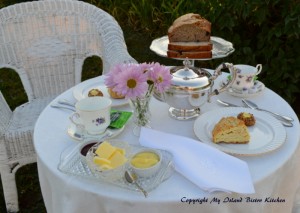
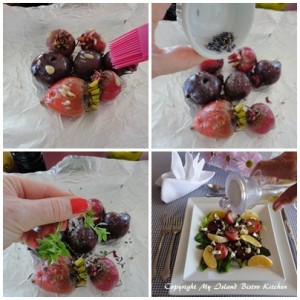
On Sunday evening I made an entire meal with lavender as the focus. For the salad course, I started with a roasted beet and goat cheese salad on garden greens. To roast the beets, I coated them with olive oil then sprinkled some fresh thyme, lemon verbena, basil, dried lavender buds, and a bit of minced garlic on them. I wrapped the beets in tin foil and roasted them at 400C for about 1 hour, till they were fork tender. I then sliced the beets and laid them on a bed of lettuce freshly picked from our garden, added some orange sections, and tossed some goat cheese and pecans on the top. I made a simple citrus-based vinaigrette to drizzle over the salad. The beets had a nice roasted flavour to them, not strong in any herb flavour, which is the taste I was aiming for.
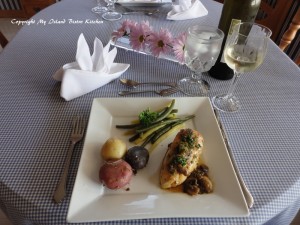
For the main course, I chose a recipe from Sharon Shipley’s “The Lavender Cookbook” for Lavender Chicken Breasts in Champagne Sauce. This was delicious. The chicken breasts were marinated in lemon juice, thyme, and ground lavender buds then cooked in a skillet with a wonderful mushroom and champagne sauce.
For dessert, I wrapped my homemade Lavender-Honey-Vanilla Ice Cream in a dessert crepe and drizzled it with raspberry coulis made with fresh PEI raspberries picked near Hunter River. The ice cream, my feature recipe for this posting, is also good with a hot fudge sauce or drizzled with a good quality chocolate or raspberry balsamic vinegar that has been reduced to syrup stage.
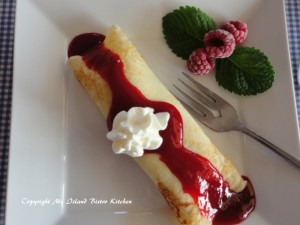
The lavender farm at the Five Sisters of Lavender Lane is located at 1433 Route 246 in Kelly’s Cross, PEI. Check out their website at http://www.fivesistersoflavenderlane.com/ or call them at 902-658-2203.
Thank you for visiting “the Bistro” today. There are lots of ways to connect with “the Bistro” through social media:
Join My Island Bistro Kitchen on Facebook
Follow the Bistro’s tweets on twitter @PEIBistro
Find the Bistro on Pinterest at “Island Bistro Kitchen”
Follow along on Instagram at “peibistro”
Lavender-Honey-Vanilla Ice Cream
By Published: August 9, 2012
- Yield: Apx. 1 quart
Lavender-infused homemade ice cream
Ingredients
- 1 cup whipping cream
- 1 cup half-and-half
- 1 cup whole milk
- 1/2 cup honey
- 2 tbsp caster sugar
- 3/4 tsp edible lavender flower buds
- 4 egg yolks
- 1/8 tsp salt
- 1/2 vanilla bean split and seeds scraped
- 1 tsp pure vanilla
Instructions
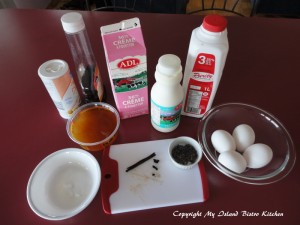 In double boiler, over medium heat, heat the whipping cream, half-and-half, milk, honey, sugar, lavender, and vanilla beans and pod. Stir occasionally and heat mixture until small bubbles start to appear around edge of mixture, about 10-12 minutes.
In double boiler, over medium heat, heat the whipping cream, half-and-half, milk, honey, sugar, lavender, and vanilla beans and pod. Stir occasionally and heat mixture until small bubbles start to appear around edge of mixture, about 10-12 minutes.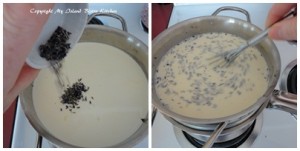 Remove from heat, cover, and let steep for 30 minutes to allow the lavender flavour to infuse the warm milk mixture.
Remove from heat, cover, and let steep for 30 minutes to allow the lavender flavour to infuse the warm milk mixture.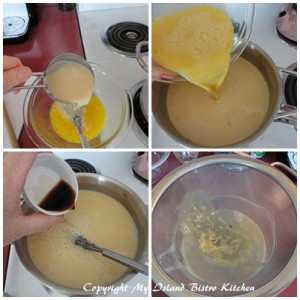 Strain mixture through a fine mesh sieve into a clean bowl. Discard remains in sieve and return strained mixture to a clean double boiler and heat to the scalding point, stirring to prevent the mixture from curdling or sticking to the bottom of the pot.
Strain mixture through a fine mesh sieve into a clean bowl. Discard remains in sieve and return strained mixture to a clean double boiler and heat to the scalding point, stirring to prevent the mixture from curdling or sticking to the bottom of the pot.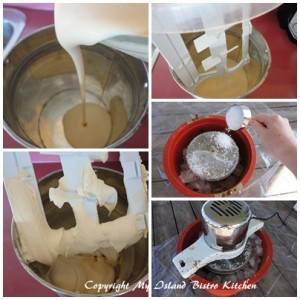 In a medium-sized bowl, whisk egg yolks and salt together. Whisk in vanilla. Add ¾ cup of the hot milk mixture to the eggs and whisk to blend. Pour this mixture into the custard in the double boiler. Cook over medium heat, stirring constantly until mixture thickens to consistency that it will coat the back of a wooden spoon. Do not boil. Be patient as this takes time.
In a medium-sized bowl, whisk egg yolks and salt together. Whisk in vanilla. Add ¾ cup of the hot milk mixture to the eggs and whisk to blend. Pour this mixture into the custard in the double boiler. Cook over medium heat, stirring constantly until mixture thickens to consistency that it will coat the back of a wooden spoon. Do not boil. Be patient as this takes time.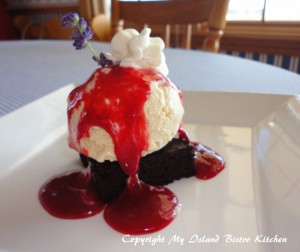 Strain mixture through sieve into a clean bowl. Cool completely then chill, covered, in refrigerator for at least 3 hours or more (can be chilled up to 24 hours). Freeze custard in ice cream maker according to manufacturer’s directions. Transfer ice cream to an airtight container and place plastic wrap directly on the surface of the ice cream. Cover and place in freezer for at least 4-6 hours to harden completely.
Strain mixture through sieve into a clean bowl. Cool completely then chill, covered, in refrigerator for at least 3 hours or more (can be chilled up to 24 hours). Freeze custard in ice cream maker according to manufacturer’s directions. Transfer ice cream to an airtight container and place plastic wrap directly on the surface of the ice cream. Cover and place in freezer for at least 4-6 hours to harden completely.
WordPress Recipe Plugin by ReciPress

